AI Overviews Research: Analyzing sources in Google’s AI-generated answers
September 2024 update:
Our latest findings reveal shifts in the AI Overview behavior. Read our August AI Overviews research for fresh data and insights on how AIOs and Google Ads coexist in search.
Google AI Overviews are dynamic. This makes estimating traffic and predicting conversions difficult for SEO specialists, website owners, and businesses. Our purpose for these studies is to help you keep your finger on the pulse of AI-powered search trends and make informed decisions. How do we do it? By providing you with relevant data and insights you can use.
In fact, our SGE study in February and our AIO pre vs. post-rollout comparison in June 2024 revealed some important insights into basic AIO behavior. We’re digging much deeper this time.
Now we are focusing on the sources used by AI Overviews. This will help us better understand who Google prioritizes in its AI-generated answers. Consider using this information to come up with ways to optimize your content better while maintaining your visibility in the new search results. Also, in this study, we used accounts without Google Labs to give a more realistic view of how AIOs function for ordinary users.
The SE Ranking team has also launched its unique AI Overviews Tracker designed to help users better understand the new GenAI era of search and introduced AIO SERP detecting features in Competitive and Keyword Research tools. You can sign up for our free trial to experience these innovative solutions. In the meantime, SE Ranking brings valuable studies to the industry using this solution and the data it provides.
Now, let’s look at what we’ve discovered and what it means for your SEO strategy moving forward.
Key takeaways
- Only 7.47% of searches (7,475 keywords) triggered AI Overviews during this study.
- The average AIO text length dropped from 4,342 to 2,633 characters (almost a 40% decrease). The average AIO word count is 397 words.
- The Relationships niche continues to dominate with 40.64% of keywords triggering AIOs.
- Prompt-type queries with a search volume of fewer than 50 and CPC fewer than $0.50 continue to trigger the majority of AIOs.
- AIOs and featured snippets appear together 63.67% of the time, while the link in featured snippets matches the link in AIOs at a 63.63% rate.
- The most frequently occurring number of links before expanding AIOs is 1 link (same as the previous research), while the most frequently occurring number of links after expanding AI-generated answers is 9 links (4 links previously).
- The Real Estate (3.71 links), Insurance (3.05 links), and Ecommerce and Retail (3 links) niches lead in average visible link count before expanding AIOs.
- AIOs link to at least one domain from the top 10 organic search results at an occurrence rate of 93.67%.
- Youtube.com (linked 1,346 times), Linkedin.com (linked 1,091 times), and Healthline.com (linked 1,091 times) are the top-linked websites in AIOs.
- The current dataset shows zero Reddit and Quora links in AIOs.
- Forbes, Business Insider, and Entrepreneur are top-linked media outlets in AIOs with 804, 148, and 45 links, respectively.
- 56.50% of all the detected links in AIOs matched search results from the top 1-100, with most (73.01%) linking to the top 1-10 search results.
- 43.50% of all detected links in AIOs matched sources outside the top 100 organic search results for keywords that triggered AIOs with these links.
- The Relationships (6,381 links), Food and Beverage (4,895 links), and Technology (3,003 links) niches have the highest number of links matching the top 30 organic search results.
- 72% of the analyzed keywords trigger AIOs with 1-4 links matching the top 10 organic search results.
- One in five AI Overviews references a government source.
- Over a quarter of AI-generated content references educational institutions or academic resources.
- Almost 10% of keywords trigger AIOs linking to .in websites.
- Only 0.25% of the detected links direct to websites with the HTTP protocol.
Disclaimer:
Our latest findings on the sources used by AI Overviews are based on the data we collected using the SE Ranking platform. This is our interpretation of the results. We acknowledge that other valid interpretations may exist.
Niche-specific findings are heavily influenced by the keywords selected for our study. Also, you may encounter AIOs linking to different websites within that niche depending on the query used.
Find out more about how we conducted this research by reading the Methodology section at the end of this article.
How have AI Overviews changed since our previous research?
Before analyzing links in Google’s AIOs, let’s briefly recap the changes in AI-powered response behavior since our last research. We’ll compare the results by using the 100,013 search queries we selected for analysis.
How has the frequency of AIO appearance in search changed?
Our latest research shows a slight decrease of 1.24% in AI Overview appearances compared to our previous study. In our earlier research, 8.71% of searches (8,718 keywords) triggered AIOs. This time, AI Overviews showed up for only 7.47% of searches (7,475 keywords).
92,440 keywords (92.43%) didn’t end with AIOs, and a minor 98 keywords (0.10%) resulted in a technical error where Google couldn’t generate an AI response.
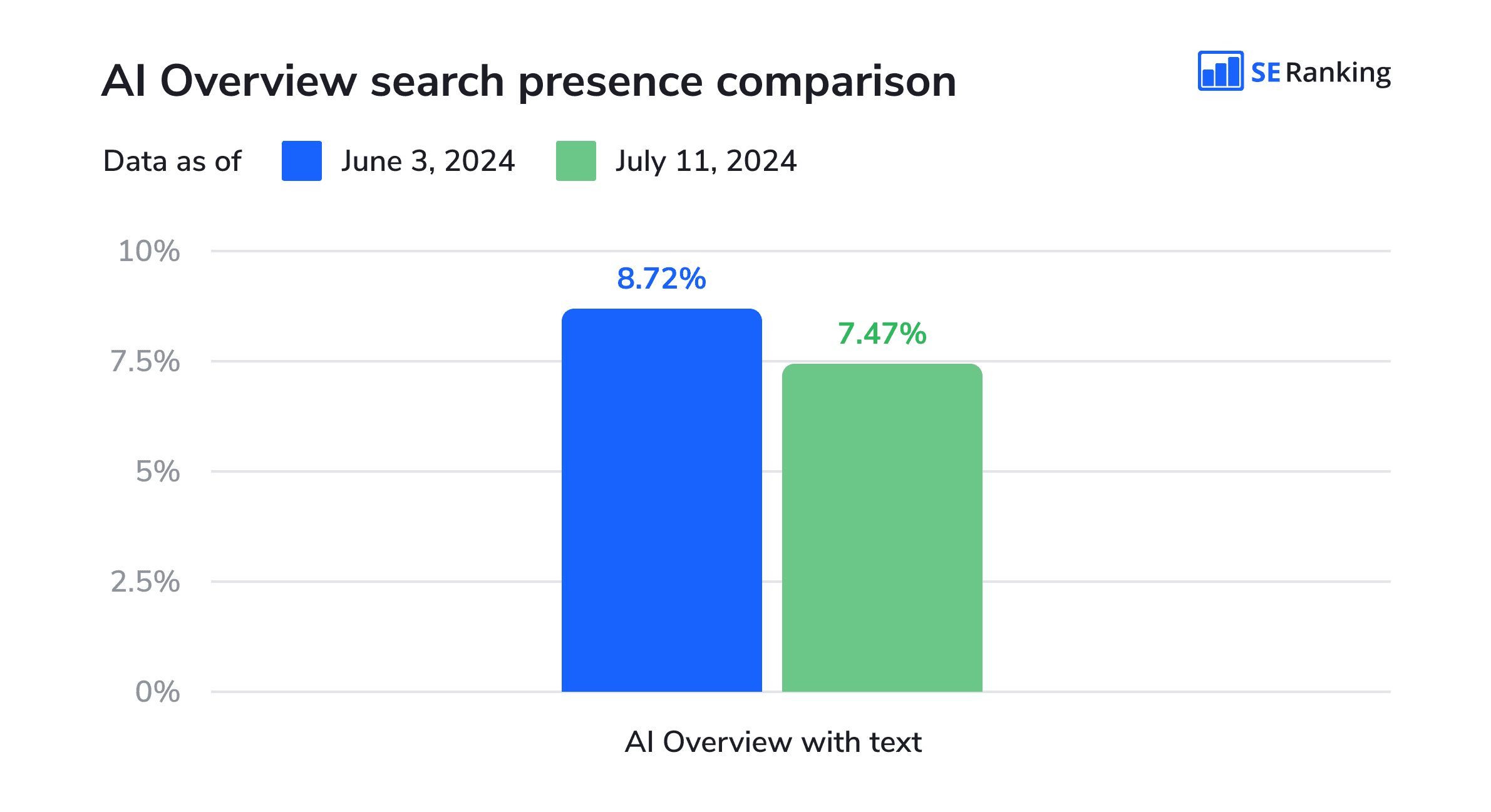
As for the keyword overlap between these two studies, we found out that 88,329 (88.32%) keywords didn’t trigger AIOs in either period, and 11,684 (11.68%) triggered AIOs in at least one period.
Out of them:
- 2,966 keywords (25.39%) triggered AIOs in the new study only.
- 4,509 keywords (38.59%) triggered AIOs in both periods.
- 4,209 keywords (36.02%) triggered AIOs in the previous study only.
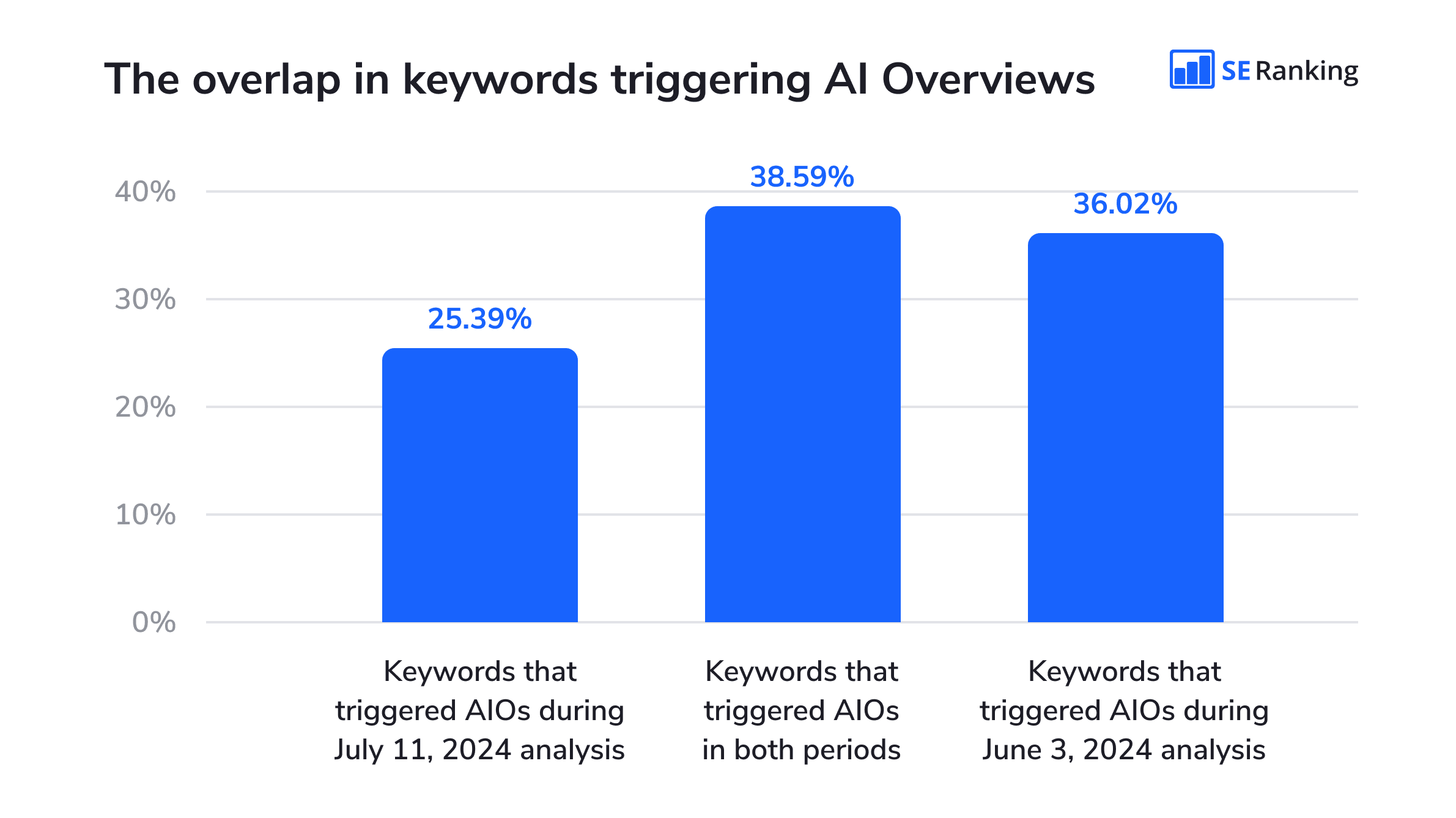
How has the AI Overview average text length changed?
According to the data in our latest study, the average AIO text length is 2,633 characters. In our previous study, that value was 4,342 characters. That’s a decrease of about 39%.
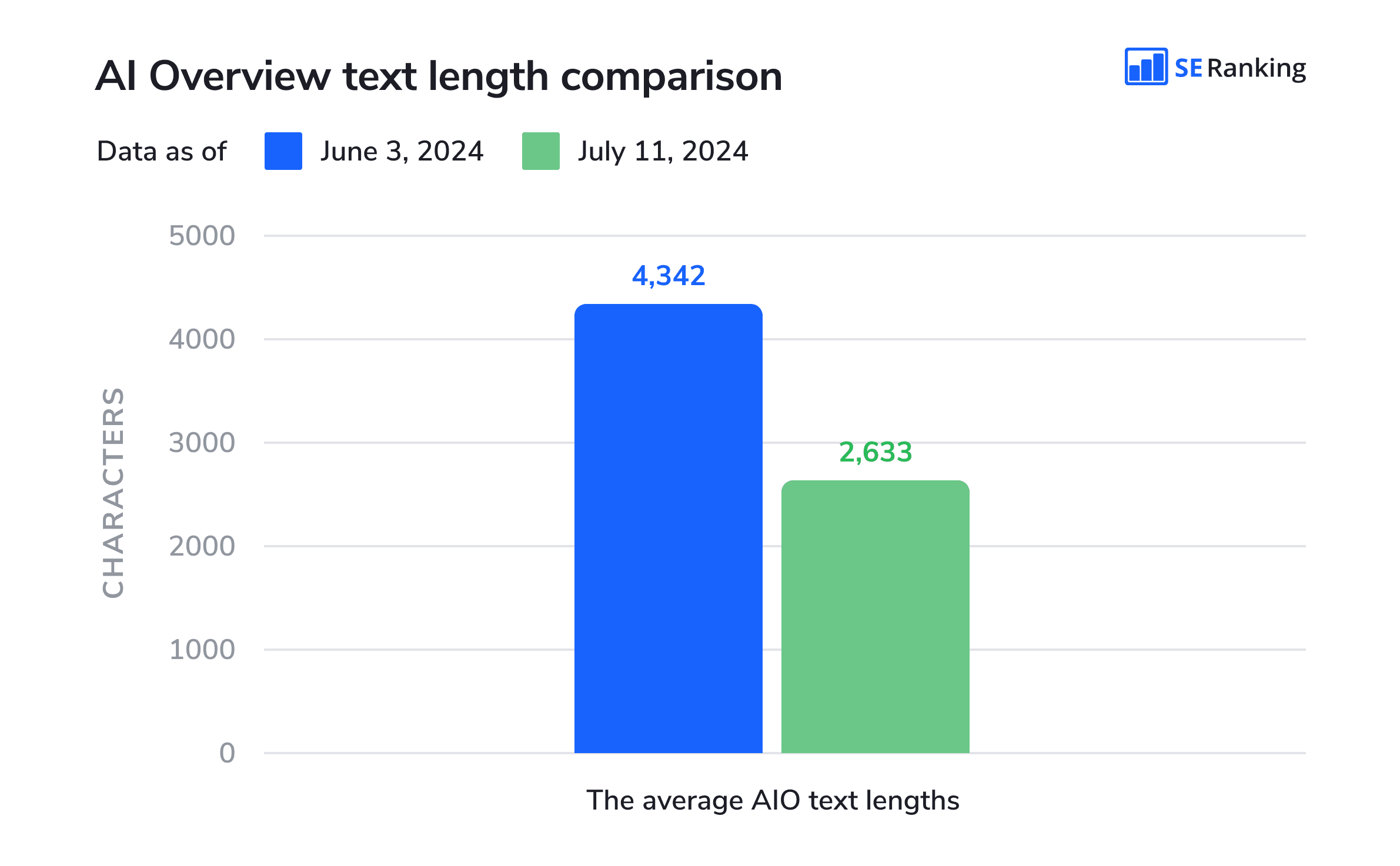
Additionally, the average AIO text length in words is about 397 words per AI-powered answer in search.
How has the distribution of AI Overviews changed across different niches?
Our most recent findings reveal some interesting shifts in how different niches trigger AIOs. After analyzing 20 niches, with each being represented by around 5,000 keywords, and then comparing this data, we can see that:
- The Relationships niche still dominates, jumping from 26.62% to 40.64% of keywords triggering AIOs.
- The Food and Beverage niche holds steady, maintaining its second-place position with a slight decrease from 24.78% to 23.58%.
- The Business and Technology niches have swapped places with the Business niche moving up to third (from 16.88% to 18.48%) and the Technology niche slipping to fourth (from 18.11% to 17.17%).
- The Self-Care and Wellness niche is a new entrant to the top five (15.66%), replacing the Pets niche (1.04%).
- The Fashion and Beauty, Pets, and Ecommerce and Retail niches saw a significant decline from 15.26%, 15.58%, and 12.18% to 0.24%, 1.04%, and 0.28%, respectively. Note that these three niches had the most keywords with commercial search intent, making this quite an interesting drop in the number of AIOs. It merits further analysis.
Niches that triggered less than 1% of AIOs have held steady onto their previous positions:
- The Legal (0.64%), Healthcare (0.56%), Career and Jobs (0.32%), News and Politics (0.68%), Cars (0.24%), and Real Estate (0.14%) niches continue to have low AIO trigger rates.
- The Travel niche has gained ground, moving from less than 1% to 1.32%.
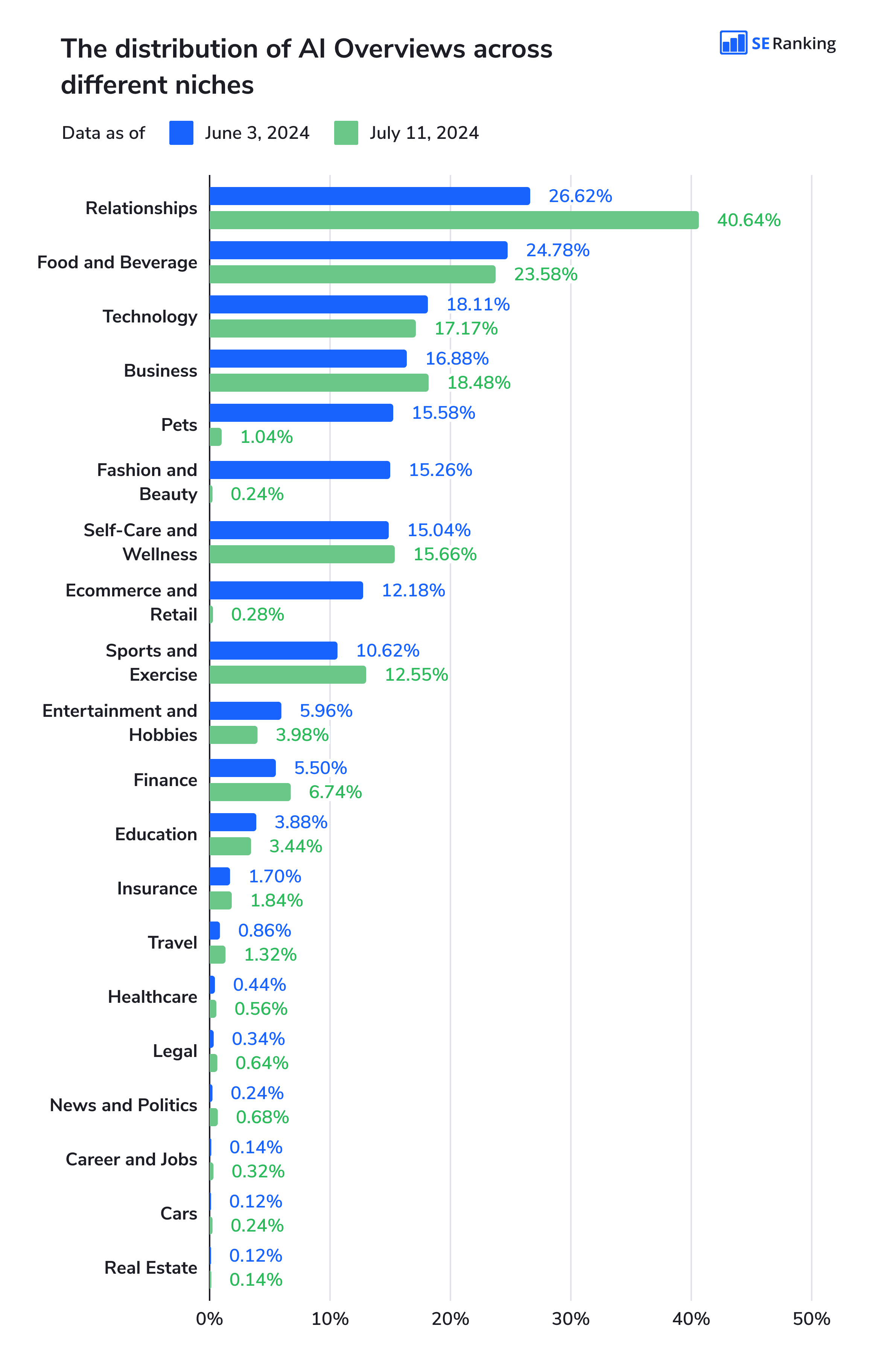
How has the interplay between featured snippets and AI Overviews changed?
AIOs and featured snippets are appearing together more frequently. Previously, they co-occurred 45.39% of the time (3,957 out of 8,718 cases), but now AIOs and featured snippets accompany each other 63.67% of the time (4,759 out of 7,475 cases).
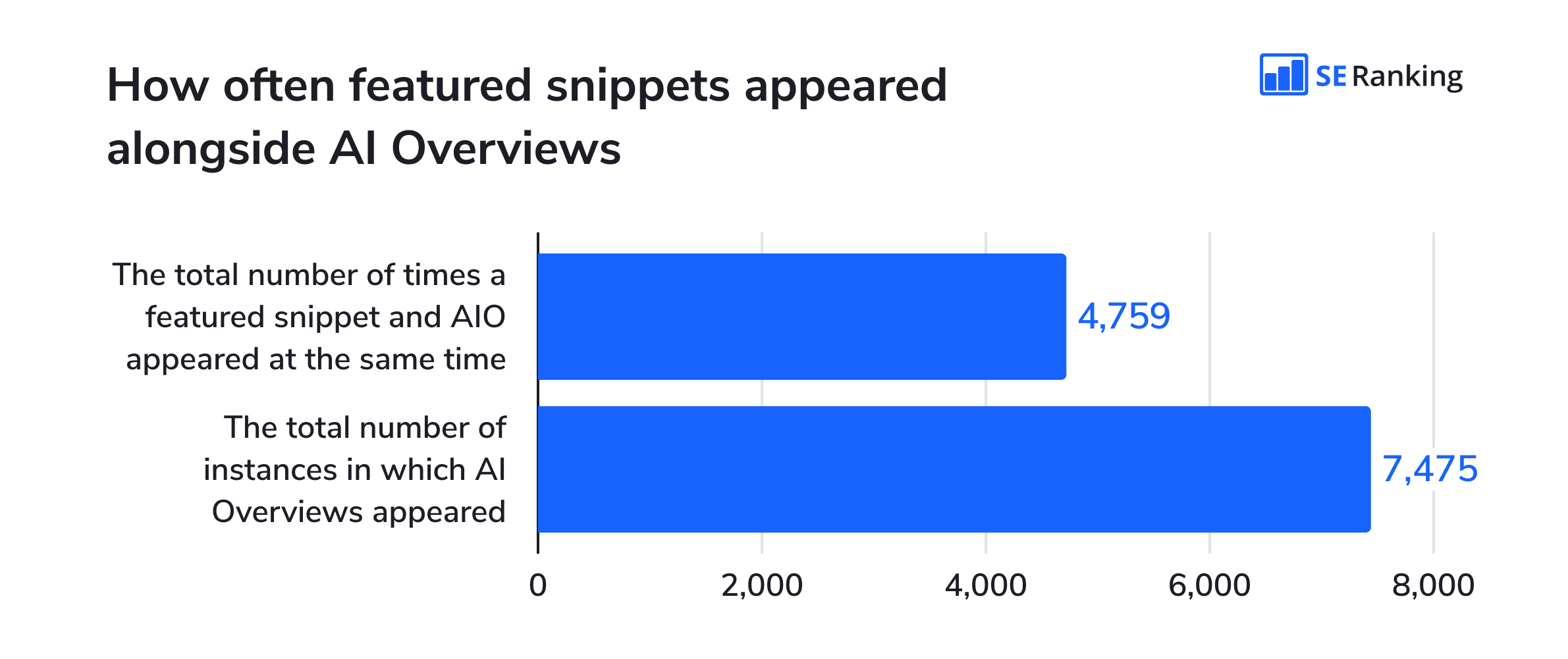
When AIOs aren’t present, featured snippets have become less common, dropping from 8.61% (7,856 out of 91,295 keywords) to 6.04% (5,585 out of 92,538 keywords).
The number of instances featuring a link match between an AIO and a featured snippet has increased slightly, from 61.79% (2,445 out of 3,957 instances) to 63.63% (3,028 out of 4,759 instances).
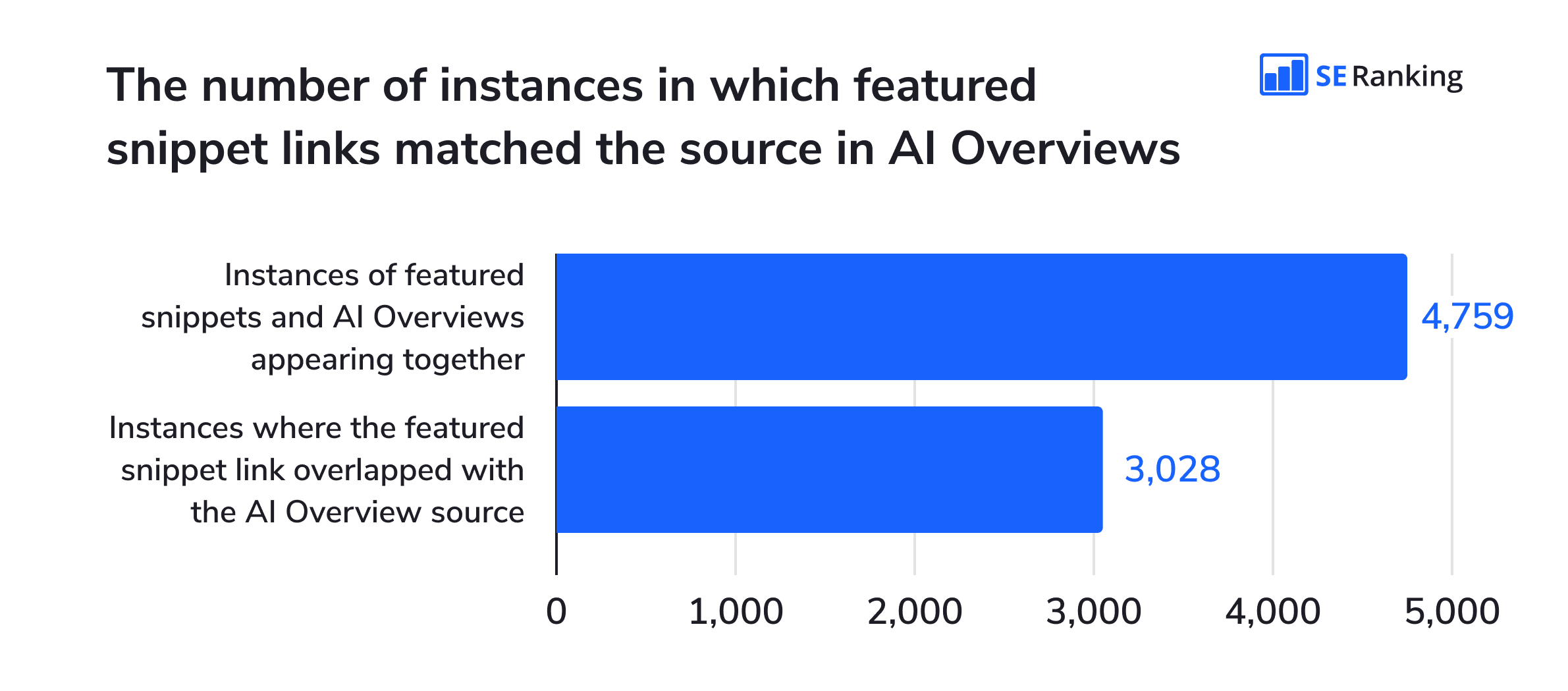
Do long-tail queries with low search volume and low CPC still trigger the most AIOs?
Our new analysis continues to reveal obvious patterns in keyword types most likely to trigger AIOs. Several of our research studies show the same AIO behavior, indicating a consistent pattern.
- Ten-word queries have seen a significant jump in their ability to trigger AIOs, from 19.10% previously to 32.02% now.
- Low-volume keywords are still strong triggers for AIOs. Keywords with search volumes from 0 to 50 previously triggered AIOs 33.21% of the time. This trend has grown. This keyword type currently triggers AIOs 38.06% of the time.
- Lower CPC keywords are even more likely to trigger AIOs now. Previously, queries with CPC from $0 to $0.5 resulted in AIOs 53.65% of the time. They currently trigger AIOs 60.67% of the time.
The reduction in AIOs suggests that Google is continually refining its system, prioritizing quality and relevance over quantity. The search giant explains that it created AIOs to provide additional benefits beyond the typical user search. These AI snippets are intended to appear in search results when Google’s systems determine that generative AI can offer distinct value.
The 39% reduction in AIO text length suggests a shift toward more concise content inside AIOs. One theory is that Google wants to be more straight and to-the-point with its AI-powered answers. This may impact how content should be structured for SEO.
Several studies show an increased co-occurrence of featured snippets and AIOs, as well as the impact of long-tail, prompt-type queries with low search volume and low CPC. This is why it’s crucial to highlight the benefits of creating content strategies aimed for visibility in both featured snippets and AIO, as well as broadening keyword research to include detailed, specific queries that are less competitive but highly relevant.
Let’s move on to the core topic of our research, analyzing resources in AI Overviews.
How many sources do AI Overviews feature?
We focused on the number of sources (links) that users can see before expanding the AIO through the Show More button (pre-click links) and after expanding (post-click links).
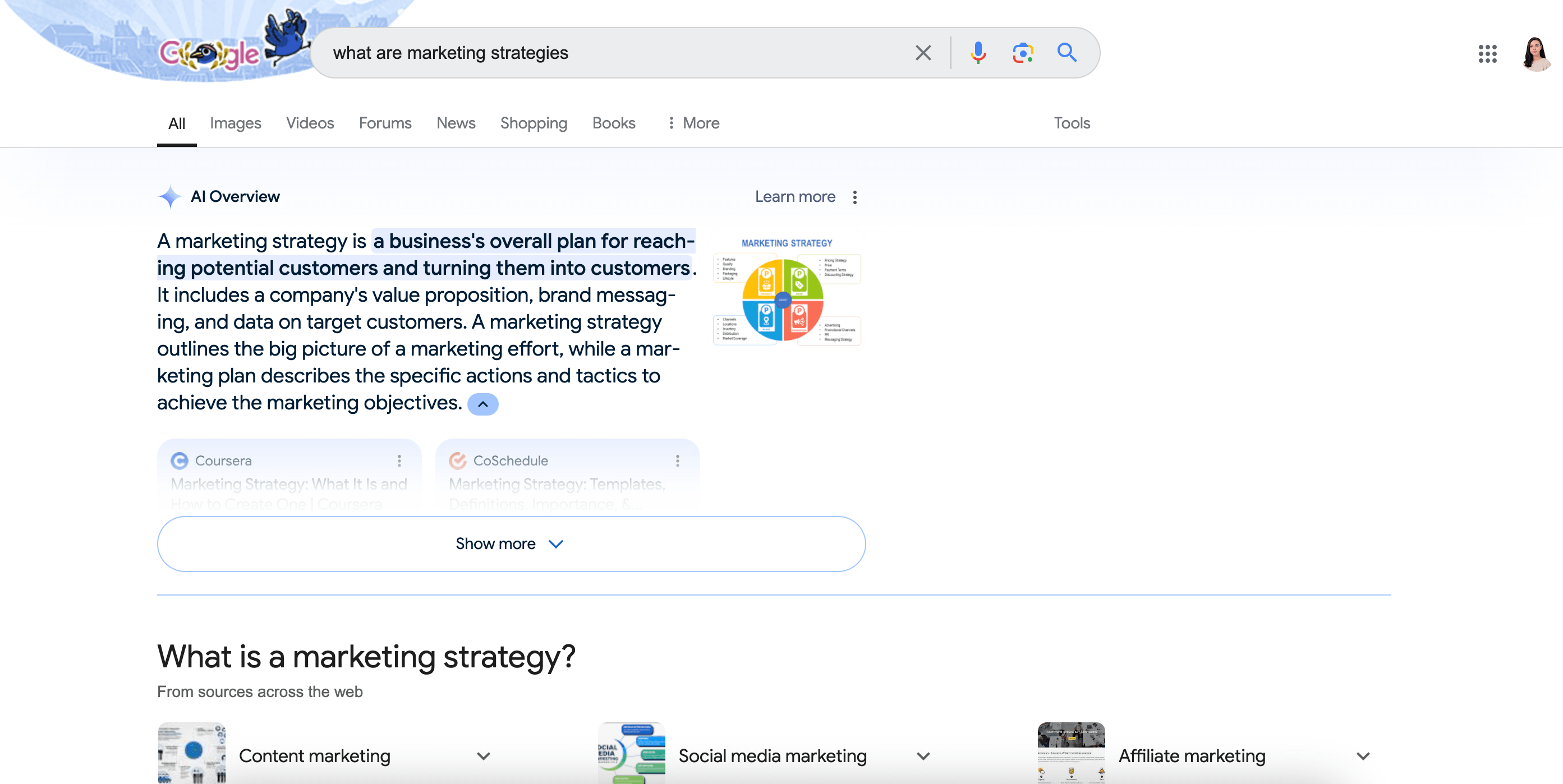
The maximum number of pre-click links is 10 links (19 links previously), while the most frequently occurring number of pre-click links has remained the same, 1 link.
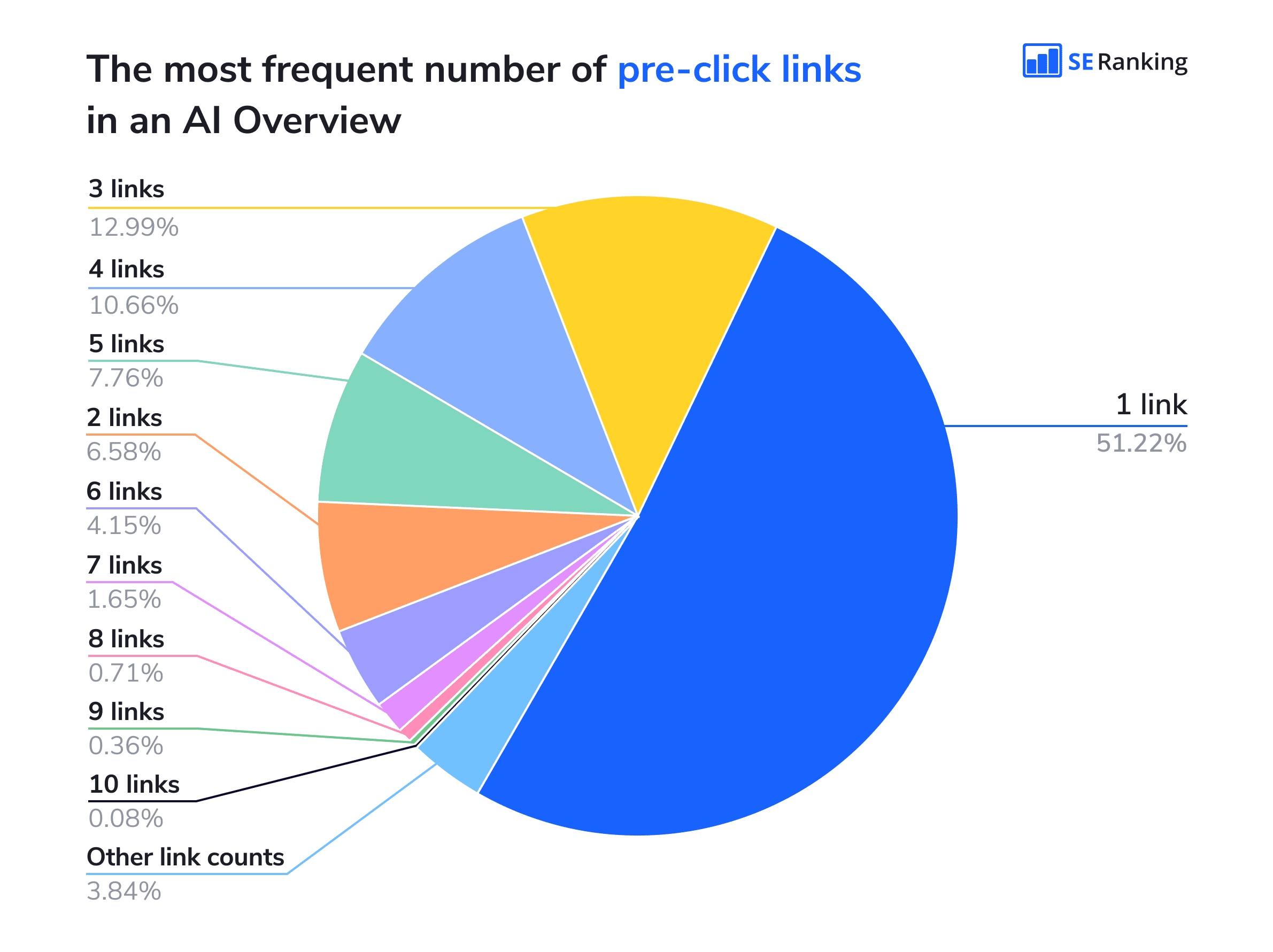
The highest number of post-click links is 13 links (26 links previously), and the most frequently occurring number of post-click links is 9 links (4 links previously).
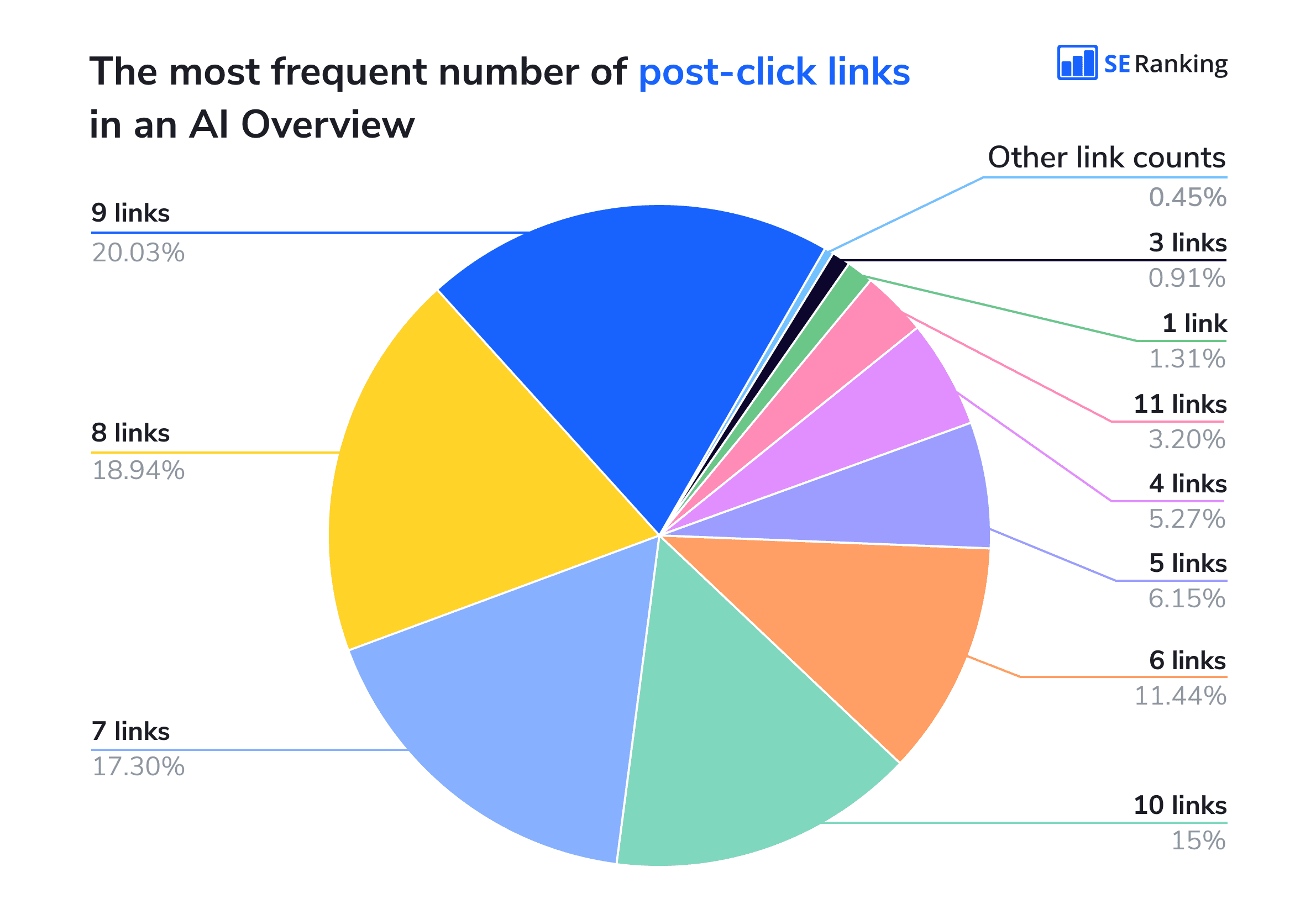
What’s the average number of pre and post-click links across different niches?
The average number of pre-click links across researched niches is 2.5 links (a slight increase compared to the previous result of 2.2 links). The average number of post-click links is 7.2 links (a bigger increase, from 5.5 links previously).
Since our previous analysis, the leaders in the average number of pre-click links changed from Healthcare (3.14 links), Legal (3.12 links), and Finance (3.12 links) to:
- Real Estate (3.71 links)
- Insurance (3.05 links)
- Ecommerce and Retail (3 links)
The leader of the biggest average number of post-click links also changed from Travel (7.30 links) to Education (8.15 links). The top 2 and top 3 spots switched from Relationships (7.06 links) and Sports and Exercise (6.94 links) previously to Sports and Exercise (8.08 links) and Relationships (8.00 links) now.
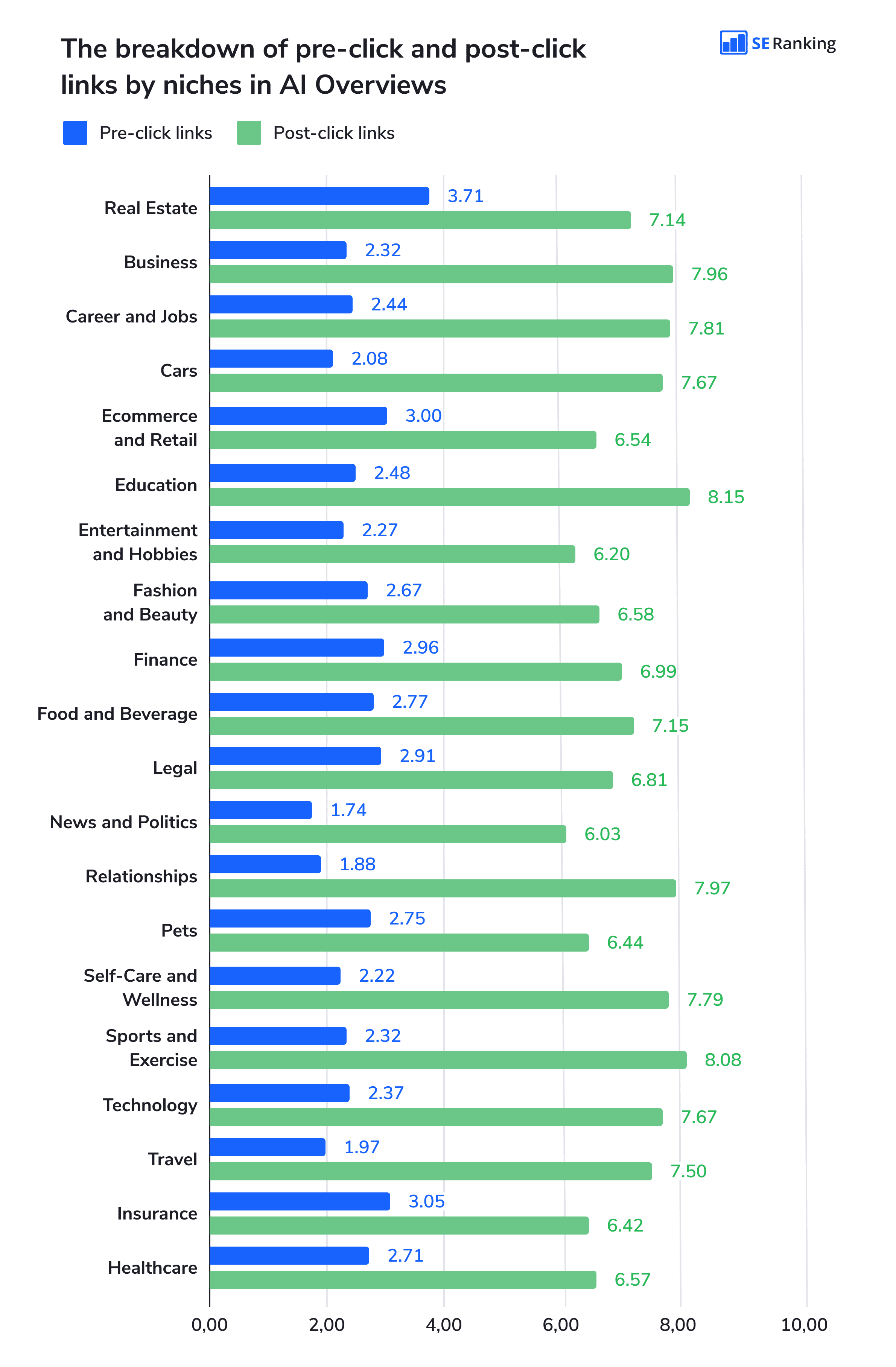
Given that AIOs often include only one pre-click link, website owners can still have an opportunity for visibility in organic search. To maintain a good CTR, websites should strive to be the primary source in organic search results below AIOs. This means crafting high-quality, accurate content that directly addresses user queries.
However, the results page can also contain other SERP features and ads. These can push organic results further down. This means you should continue optimizing your content to get featured both in AIOs and top organic search results.
We also found that the average number of links in AIOs increased slightly. Combined with the decreased AIO text length, we can assume that Google raised the average number of links to make its AIOs look more trustworthy. This change also allows users to learn more about the query topic through linked sources.
What are the top-linked websites in AI Overviews?
The top 5 linked websites are:
- Youtube.com (linked 1,346 times)
- Linkedin.com (linked 1,091 times)
- Healthline.com (linked 1,091 times)
- Verywellmind.com (linked 855 times)
- Forbes.com (linked 804 times)
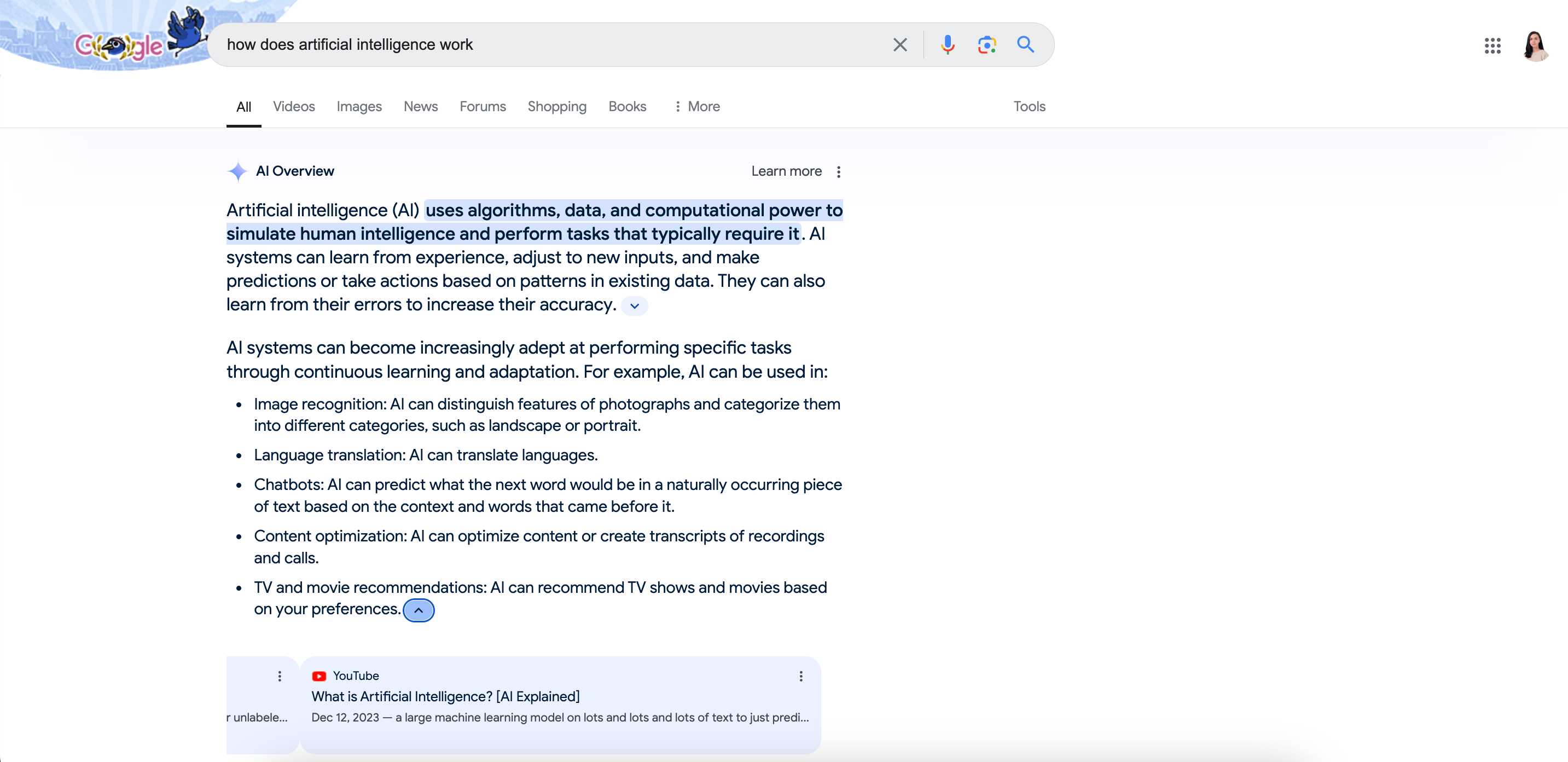
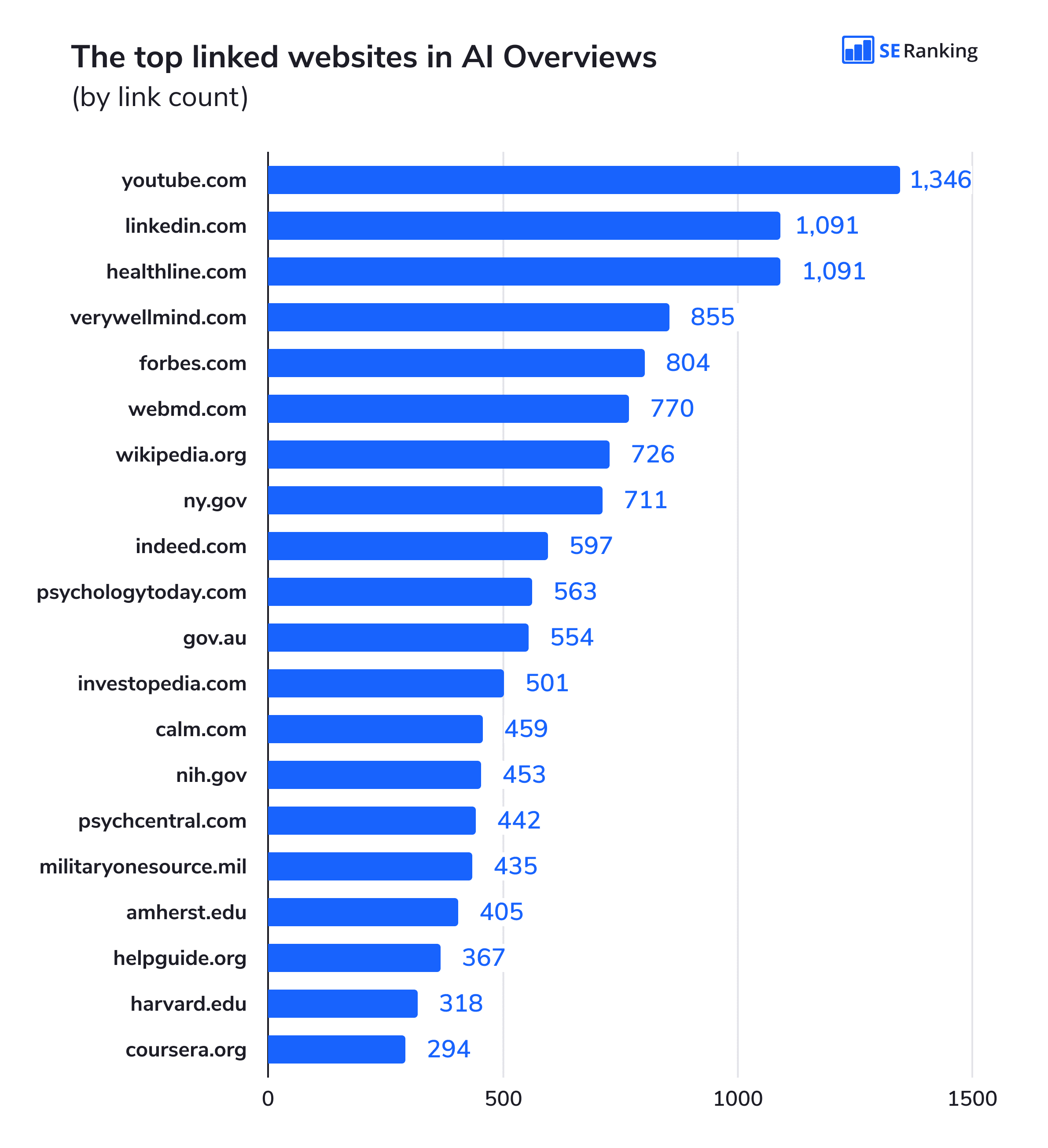
After checking the 20 top-linked websites with SE Ranking, we identified that:
- According to our Backlink Checker, they have between 24K to 24.10M referring domains and between 247K to 38.50B backlinks. However, there is an exception here—gov.au. We detected only 196 referring domains and 643 backlinks on this website.
- According to our Competitive Research Tool, they have between 531K to 1.07B organic keywords and 213K to 8.14B organic traffic.
- According to our Website Audit Tool, these top-linked websites were created between 1985 and 2017, with an average age of around 25 years. Two domains were established in 1985 and 1986, 9 were created between 1990-1999, 2 domains were founded in 2001-2005, and 2 newer websites were launched in 2012 (coursera.org) and 2017 (verywellmind.com). There were also 3 domains we couldn’t get data for.
To review the distribution by niches, check out this file. It contains a list of the top 10 linked websites in each sector, with details on organic keywords, traffic, backlinks, referring domains, and more.

Do AI Overviews pull domains from the TOP 10 organic search results?
Out of the 7,475 cases where SERPs included an AI Overview, there were 7,002 instances (93.67%) where AIOs linked to at least one domain from the top 10 organic search results.
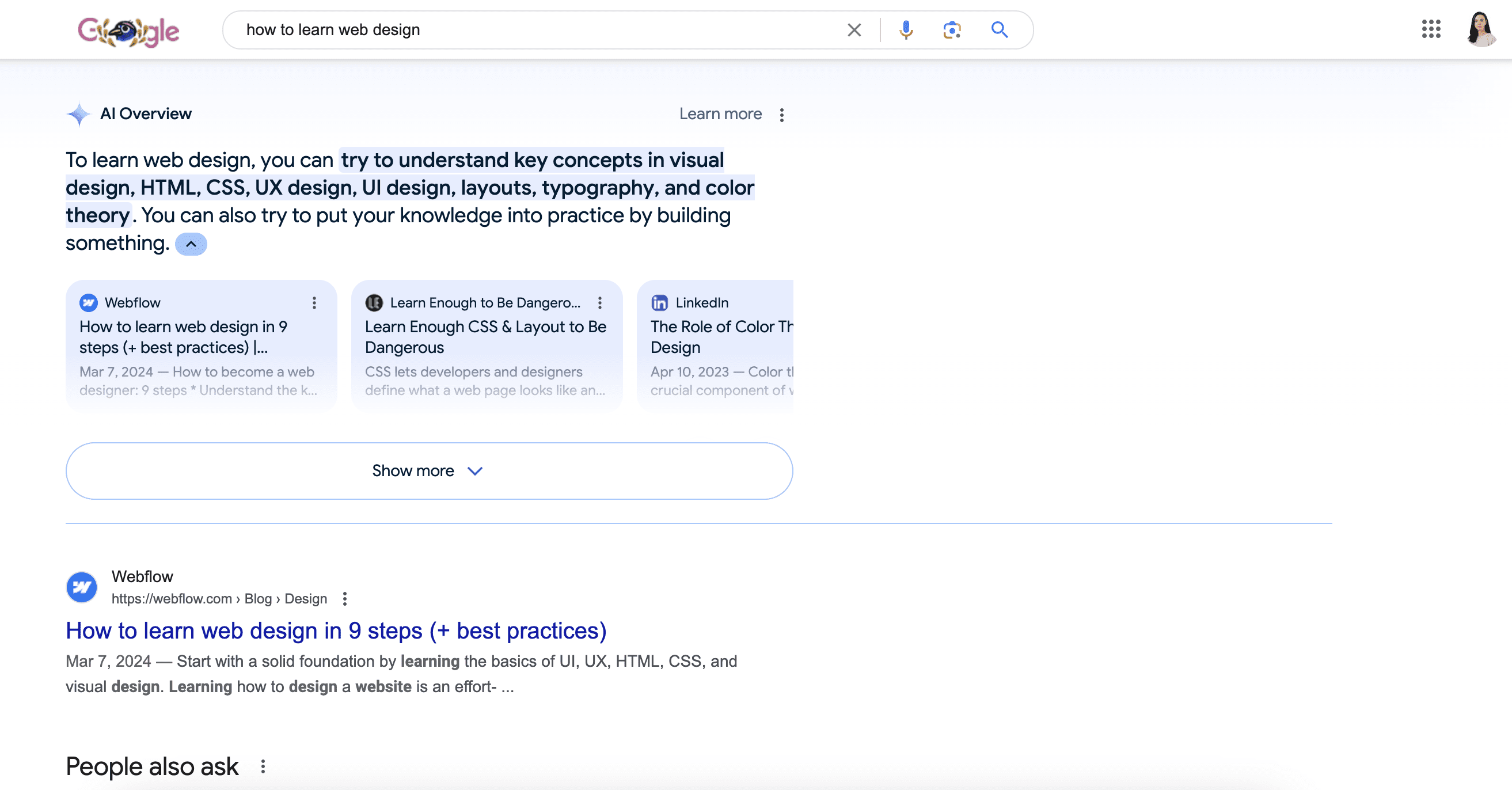
Important note! This section focuses on domains, not links. You’ll find more detailed information on link intersection in the following sections.
In 473 cases (6.33%), AIOs did not overlap with any of the top 10 organic domains.
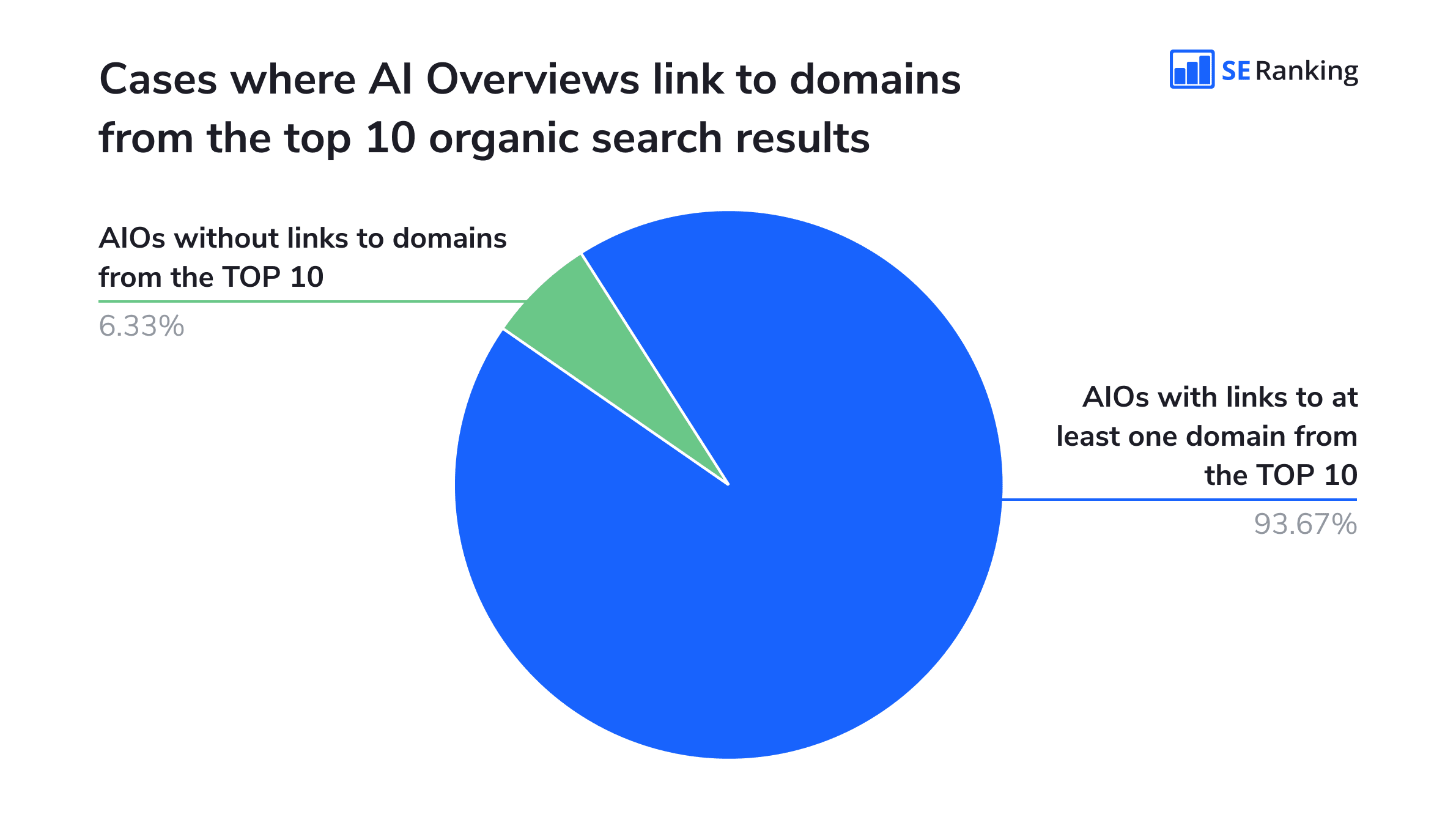
Here is our list of the top 20 most frequent domains appearing in the top 10 organic search results and AIOs simultaneously:
The number of domain links that appeared both in AIOs and the top 10 organic search results
730
The number of domain links that appeared both in AIOs and the top 10 organic search results
562
The number of domain links that appeared both in AIOs and the top 10 organic search results
554
The number of domain links that appeared both in AIOs and the top 10 organic search results
500
The number of domain links that appeared both in AIOs and the top 10 organic search results
450
The number of domain links that appeared both in AIOs and the top 10 organic search results
426
The number of domain links that appeared both in AIOs and the top 10 organic search results
382
The number of domain links that appeared both in AIOs and the top 10 organic search results
333
The number of domain links that appeared both in AIOs and the top 10 organic search results
319
The number of domain links that appeared both in AIOs and the top 10 organic search results
293
The number of domain links that appeared both in AIOs and the top 10 organic search results
285
The number of domain links that appeared both in AIOs and the top 10 organic search results
260
The number of domain links that appeared both in AIOs and the top 10 organic search results
236
The number of domain links that appeared both in AIOs and the top 10 organic search results
216
The number of domain links that appeared both in AIOs and the top 10 organic search results
212
The number of domain links that appeared both in AIOs and the top 10 organic search results
202
The number of domain links that appeared both in AIOs and the top 10 organic search results
193
The number of domain links that appeared both in AIOs and the top 10 organic search results
189
The number of domain links that appeared both in AIOs and the top 10 organic search results
182
The number of domain links that appeared both in AIOs and the top 10 organic search results
181
730
562
554
500
450
426
382
333
319
293
285
260
236
216
212
202
193
189
182
181
If you are interested in the distribution by niches, check out this file.

Do AI Overview sources match pages ranking in the TOP 1-100 of organic search?
During our research, we collected 51,745 links from AI Overviews. A total of 29,234 links from AIOs (56.50%) matched the top 1-100 search results for keywords they rank for, with most linking to the top 1-10 search results. Also, 22,511 links (43.50%) matched sources outside the top 100 search results.
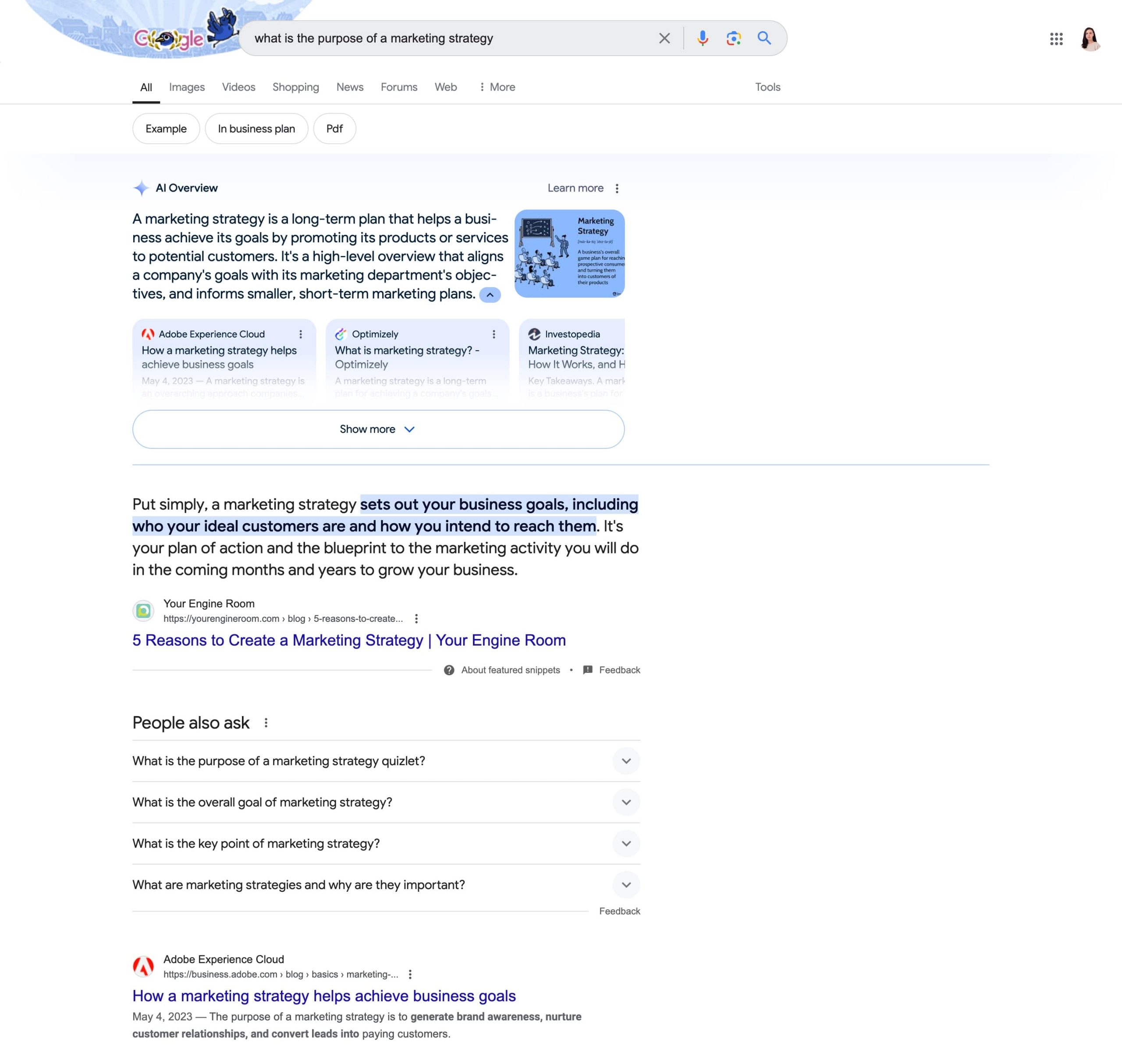
The chart below shows the distribution of the 29,234 links that matched the top 1-100 pages:
The number of matched links
21,344 links
The percentage of matched links
73.01%
The number of matched links
2,775 links
The percentage of matched links
9.49%
The number of matched links
1,263 links
The percentage of matched links
4.32%
The number of matched links
923 links
The percentage of matched links
3.16%
The number of matched links
754 links
The percentage of matched links
2.58%
The number of matched links
605 links
The percentage of matched links
2.07%
The number of matched links
539 links
The percentage of matched links
1.84%
The number of matched links
416 link
The percentage of matched links
1.42%
The number of matched links
361 links
The percentage of matched links
1.23%
The number of matched links
254 links
The percentage of matched links
0.87%
21,344 links
73.01%
2,775 links
9.49%
1,263 links
4.32%
923 links
3.16%
754 links
2.58%
605 links
2.07%
539 links
1.84%
416 link
1.42%
361 links
1.23%
254 links
0.87%
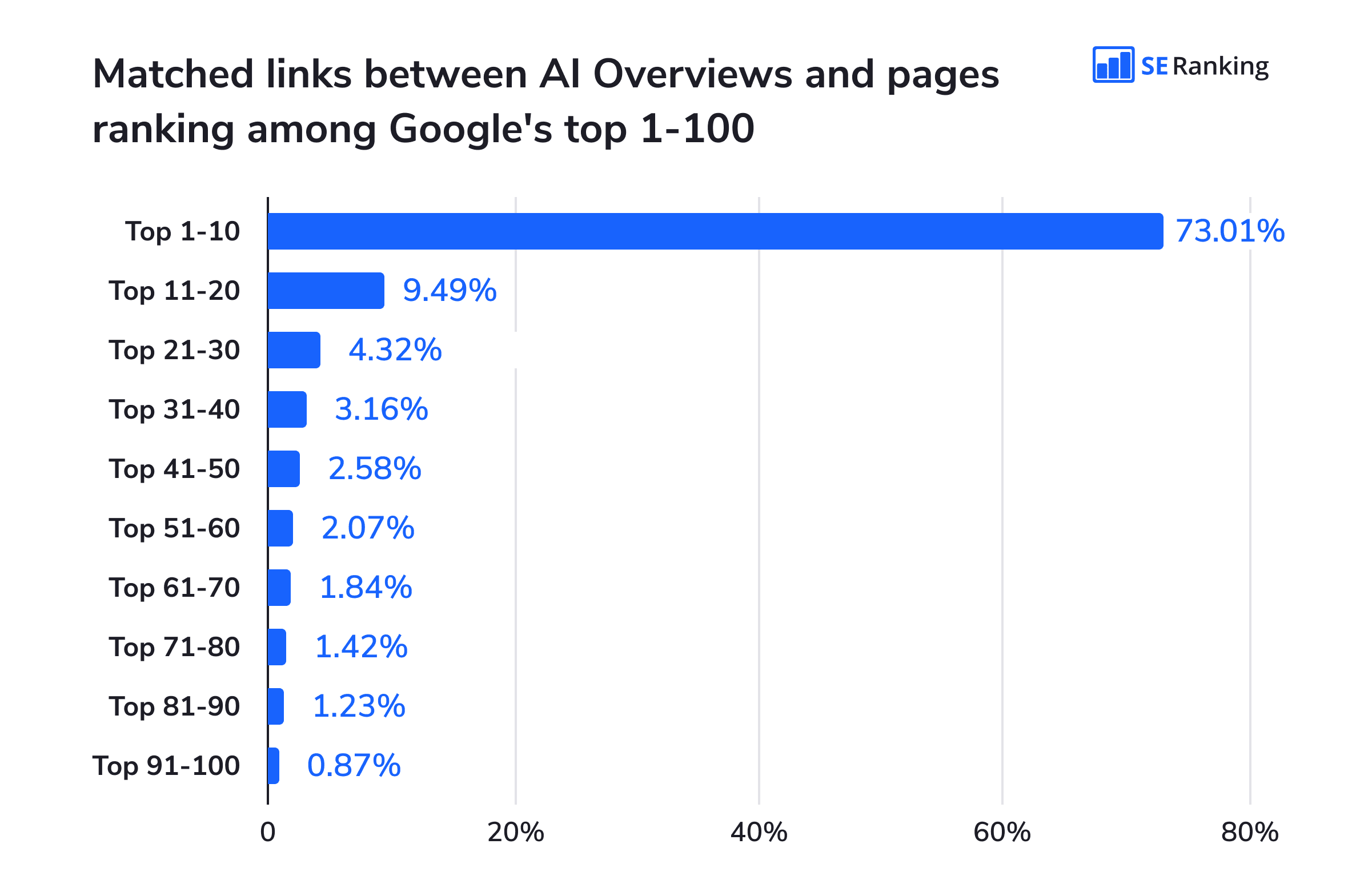
When broken down by specific niches, the data reveals how different sectors are represented within AI Overviews. However, this data strongly depends on the total number of AIOs and links present in each niche.
Below are the top 5 niches with the most matched links from the top 1-30 organic search results:
- Relationships: 6,381 links (43.38% of its total links)
- Food and Beverage: 4,895 links (64.73% of its total links)
- Technology: 3,003 links (50.87% of its total links)
- Business: 2,814 links (41.89% of its total links)
- Self-Care and Wellness: 2,572 links (47.18% of its total links)
The Real Estate, Cars, and Fashion and Beauty niches have the lowest number of matched links from the top 30 organic results (21, 28, and 30 links, respectively). Since these niches have few AIOs in general, this is a fairly straightforward result.
Niches with strong linkage outside of the top 10 include:
- Relationships: 1,394 links in the top 11-30 (21.8% of its total links)
- Sports and Exercise: 330 links in the top 11-30 (17.8% of its total)
- Self-Care and Wellness: 347 links in the top 11-30 (13.5% of its total)
- Food and Beverage: 586 links in positions 11-30 (12% of its total)
The Ecommerce and Retail niche shows a drop, with zero links outside the top 20 results.
The Healthcare, Legal, and News and Politics niches have a low but consistent linkage.
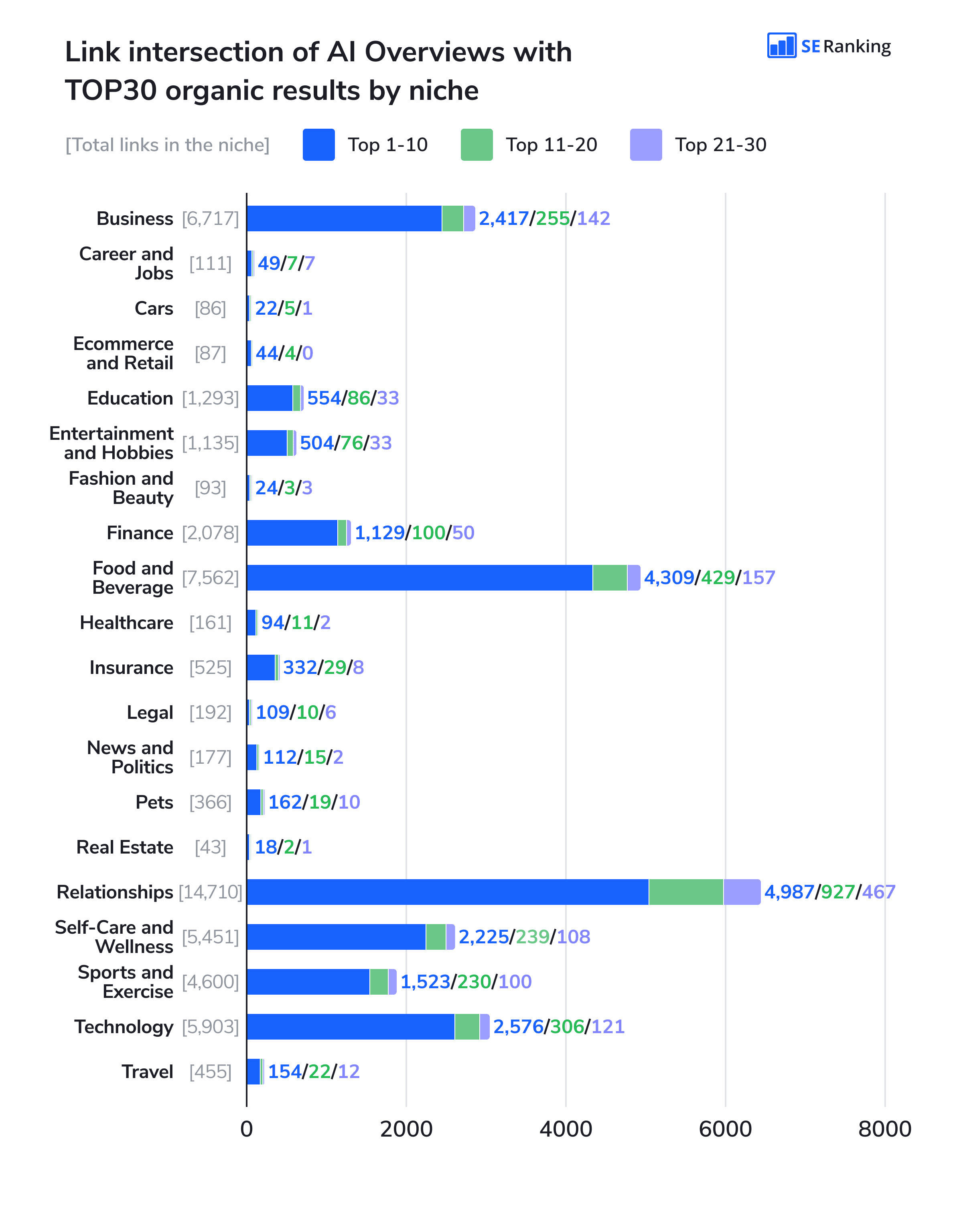
While Google prefers to reference high-ranking pages in AI Overviews, plenty of discovered links (43.50%) come from sources outside the top 100, specifically for keywords where those links were present on AIOs. This suggests that Google also values unique and highly relevant content that may not necessarily rank high for an entered query (due to competition, lower domain authority, or other factors). Google also appears to prefer content that ranks for other keywords related to the topic of the original search query.

This all suggests that Google values diversity and wants to cover different perspectives. It accomplishes this by occasionally selecting sources that aren’t ranking high or don’t rank at all for a specific keyword, the source instead ranking for queries related to the topic. Google might choose these sources because they provide unique information despite being narrowly reported. These sources could also be more relevant to a specific aspect of a query. This underlines the importance of diversifying content to cover related topics and questions that users might also be interested in.
The frequency of keywords resulting in link matches between AI Overviews and the TOP 10 search results
Most keywords (about 72%) trigger AIOs with 1-4 links matching the top 10 organic search results.
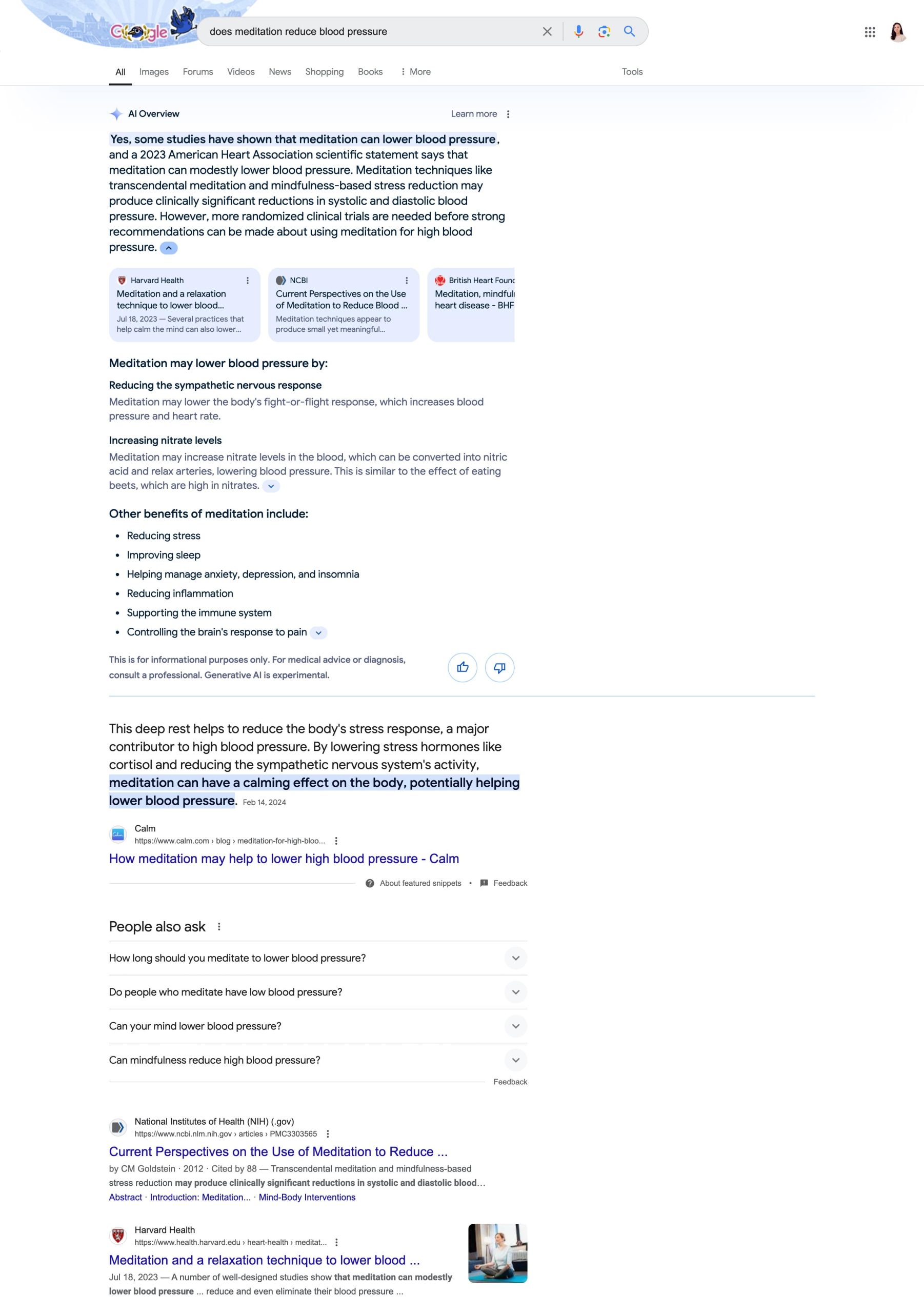
Here is a detailed breakdown of our research. It shows the total number of keywords that triggered AIOs (7,475):
The number of keywords that triggered AIOs with links matching the top 10 search results
1,528 keywords
The ratio of the total number of keywords that triggered AIOs (7,475)
20.44%
The number of keywords that triggered AIOs with links matching the top 10 search results
1,314 keywords
The ratio of the total number of keywords that triggered AIOs (7,475)
17.58%
The number of keywords that triggered AIOs with links matching the top 10 search results
1,281 keywords
The ratio of the total number of keywords that triggered AIOs (7,475)
17.14%
The number of keywords that triggered AIOs with links matching the top 10 search results
1,249 keywords
The ratio of the total number of keywords that triggered AIOs (7,475)
16.71%
The number of keywords that triggered AIOs with links matching the top 10 search results
842 keywords
The ratio of the total number of keywords that triggered AIOs (7,475)
11.26%
The number of keywords that triggered AIOs with links matching the top 10 search results
413 keywords
The ratio of the total number of keywords that triggered AIOs (7,475)
5.53%
The number of keywords that triggered AIOs with links matching the top 10 search results
84 keywords
The ratio of the total number of keywords that triggered AIOs (7,475)
1.12%
The number of keywords that triggered AIOs with links matching the top 10 search results
17 keywords
The ratio of the total number of keywords that triggered AIOs (7,475)
0.23%
The number of keywords that triggered AIOs with links matching the top 10 search results
1 keyword
The ratio of the total number of keywords that triggered AIOs (7,475)
0.01%
1,528 keywords
20.44%
1,314 keywords
17.58%
1,281 keywords
17.14%
1,249 keywords
16.71%
842 keywords
11.26%
413 keywords
5.53%
84 keywords
1.12%
17 keywords
0.23%
1 keyword
0.01%
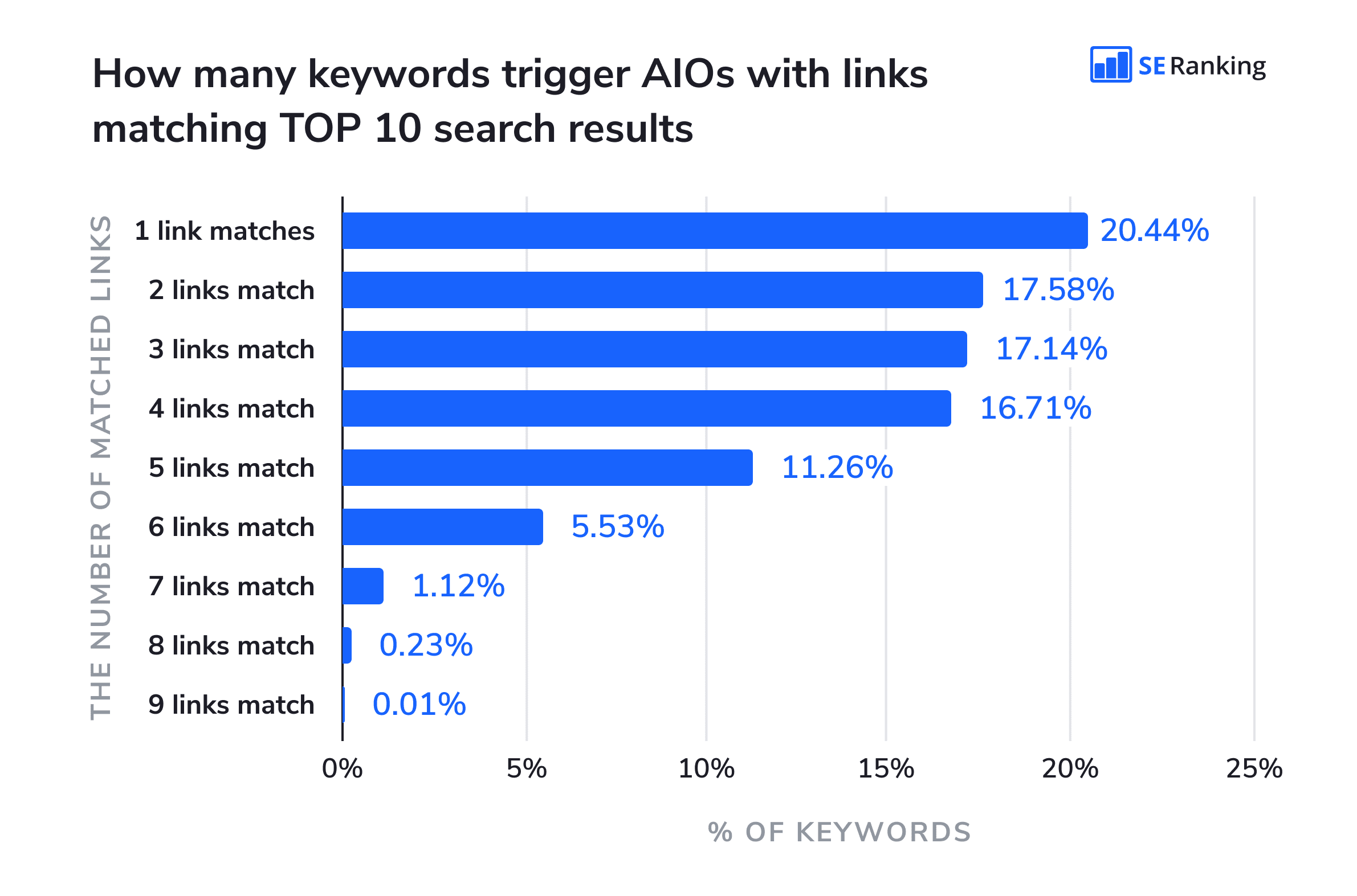
As you can see, the frequency of keywords triggering AIOs with matching links decreases as the number of matched links increases. For instance, while 1,528 keywords had one link that matched the top 10 results, only 17 keywords had eight matched links. There were 747 keywords with no matches from the top 10 search results.
We also looked at how many keywords result in a full link match. Let’s look at this question from two sides:
- Links in the AIO matching all links in the top 10 organic search results
- Links in the top 10 organic results matching all links in the AIO
The number of keywords that triggered AIOs with links matching the top 10 search results
1,528 keywords
The number of keywords that triggered SERPs where links in AIOs matched all links in the top 10 organic search results
0 keywords
The number of keywords that triggered SERPs where links in the top 10 search results matched all links in AIOs
19 keywords
The number of keywords that triggered AIOs with links matching the top 10 search results
1,314 keywords
The number of keywords that triggered SERPs where links in AIOs matched all links in the top 10 organic search results
0 keywords
The number of keywords that triggered SERPs where links in the top 10 search results matched all links in AIOs
27 keywords
The number of keywords that triggered AIOs with links matching the top 10 search results
1,281 keywords
The number of keywords that triggered SERPs where links in AIOs matched all links in the top 10 organic search results
0 keywords
The number of keywords that triggered SERPs where links in the top 10 search results matched all links in AIOs
66 keywords
The number of keywords that triggered AIOs with links matching the top 10 search results
1,249 keywords
The number of keywords that triggered SERPs where links in AIOs matched all links in the top 10 organic search results
0 keywords
The number of keywords that triggered SERPs where links in the top 10 search results matched all links in AIOs
100 keywords
The number of keywords that triggered AIOs with links matching the top 10 search results
842 keywords
The number of keywords that triggered SERPs where links in AIOs matched all links in the top 10 organic search results
0 keywords
The number of keywords that triggered SERPs where links in the top 10 search results matched all links in AIOs
133 keywords
The number of keywords that triggered AIOs with links matching the top 10 search results
413 keywords
The number of keywords that triggered SERPs where links in AIOs matched all links in the top 10 organic search results
1 keyword
The number of keywords that triggered SERPs where links in the top 10 search results matched all links in AIOs
102 keywords
The number of keywords that triggered AIOs with links matching the top 10 search results
84 keywords
The number of keywords that triggered SERPs where links in AIOs matched all links in the top 10 organic search results
0 keywords
The number of keywords that triggered SERPs where links in the top 10 search results matched all links in AIOs
21 keywords
The number of keywords that triggered AIOs with links matching the top 10 search results
17 keywords
The number of keywords that triggered SERPs where links in AIOs matched all links in the top 10 organic search results
0 keywords
The number of keywords that triggered SERPs where links in the top 10 search results matched all links in AIOs
10 keywords
The number of keywords that triggered AIOs with links matching the top 10 search results
1 keyword
The number of keywords that triggered SERPs where links in AIOs matched all links in the top 10 organic search results
0 keywords
The number of keywords that triggered SERPs where links in the top 10 search results matched all links in AIOs
1 keyword
1,528 keywords
0 keywords
19 keywords
1,314 keywords
0 keywords
27 keywords
1,281 keywords
0 keywords
66 keywords
1,249 keywords
0 keywords
100 keywords
842 keywords
0 keywords
133 keywords
413 keywords
1 keyword
102 keywords
84 keywords
0 keywords
21 keywords
17 keywords
0 keywords
10 keywords
1 keyword
0 keywords
1 keyword
As you can see from the table, there were 19 cases (keywords) where one link from the top 10 search results matched one link in AIO. In this case, the AIO only contained one link, which is considered a full match.
There was only one instance where links in the AIO matched all links from the top 10 organic search results (6 links, in that particular case). It was for the is soy in milk keyword. Also, 1 keyword (website development meaning) resulted in the top 10 search results that matched all 9 links referenced by the AIO.
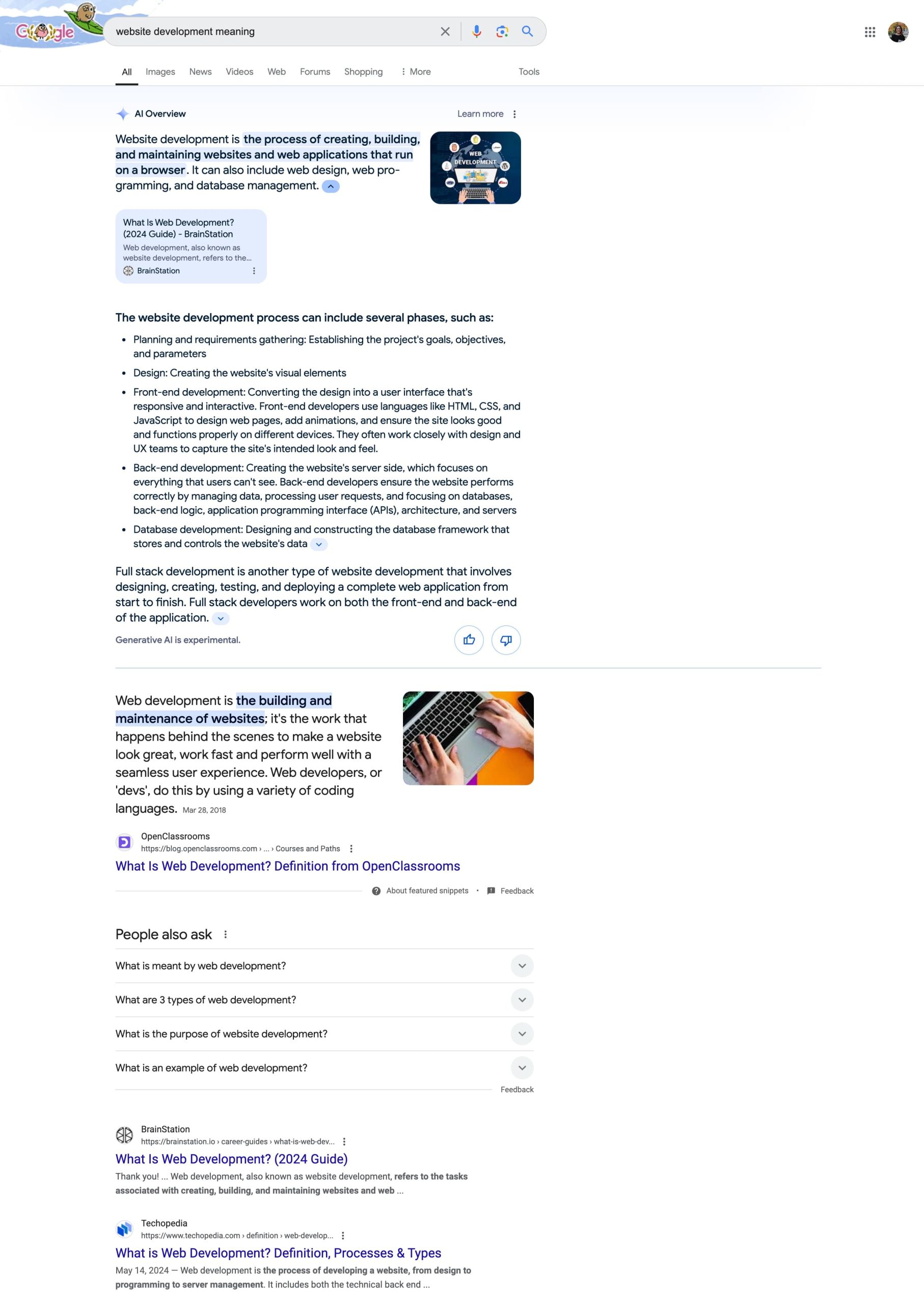
We collected this data on July 11, but the SERP and AIO are so dynamic that we couldn’t get the same results again after analyzing these findings and preparing this article. This underscores how important it is to continually monitor Google’s AI-generated responses and search results pages. This is where SE Ranking’s new AI Overviews Tracker can help. Start your free trial to track AIOs and monitor changes as they occur.
The most common number of matched links were 5, 6, and 4 links.
AIOs rarely duplicate the top 10 results extensively. Google’s system is selective when sourcing content. It tries to provide additional, complementary information instead of replicating all the existing top results. This underscores Google’s decision to show AIOs for keywords where they can provide greater value to the user.
Given the diversity of AIO link sources, websites should craft comprehensive content pieces that target not just primary keywords but also related topics and questions.
What do top links in AI Overviews have in common?
Across our sample of keywords, we examined several links appearing frequently in AI Overviews. Our goal was to understand their metrics, content, and how it was structured. Here are several examples that we’d like to share.
- https://www.hopkinsmedicine.org/health/wellness-and-prevention/9-benefits-of-yoga
Google has cited this page in AIOs more than 100 times for yoga-related keywords from the Sports and Exercise niche.
Our Competitive Research tool shows that this page ranks first in the United States for the keyword, benefits of yoga (monthly search volume: 1,210). Overall, it has organic visibility for 15.2K keywords, with estimated monthly traffic of 24.4K. The article has 2.5K referring domains and 7.5K backlinks.
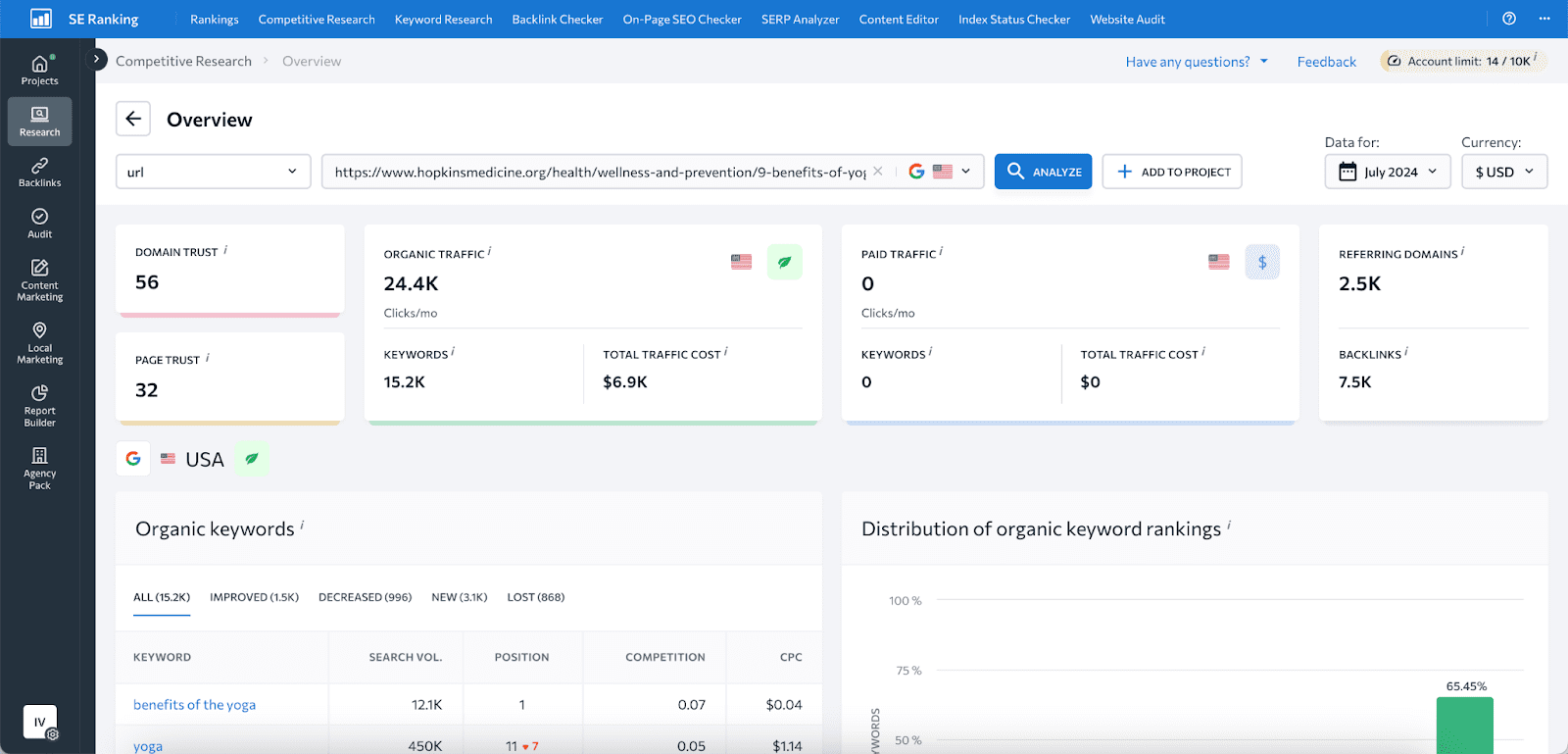
The article’s content is structured in a “9 Benefits” format with 9 numbered subsections. It contains 695 words of body content and AI detectors consider the text to be human-written. While the article doesn’t specify an author or publication date, it has detailed structured data for Articles and Organization (check results).
- https://www.mayoclinic.org/tests-procedures/meditation/in-depth/meditation/art-20045858
Google referred to this page 100+ times for meditation-related keywords from the Self-Care and Wellness niche.
It ranks first in the US for the benefits of meditation keyword (monthly search volume: 8,100). The page is visible for 24.3K keywords in organic search and its estimated traffic per month is 22.1K. The article has 7.1K referring domains and 17.3K backlinks.
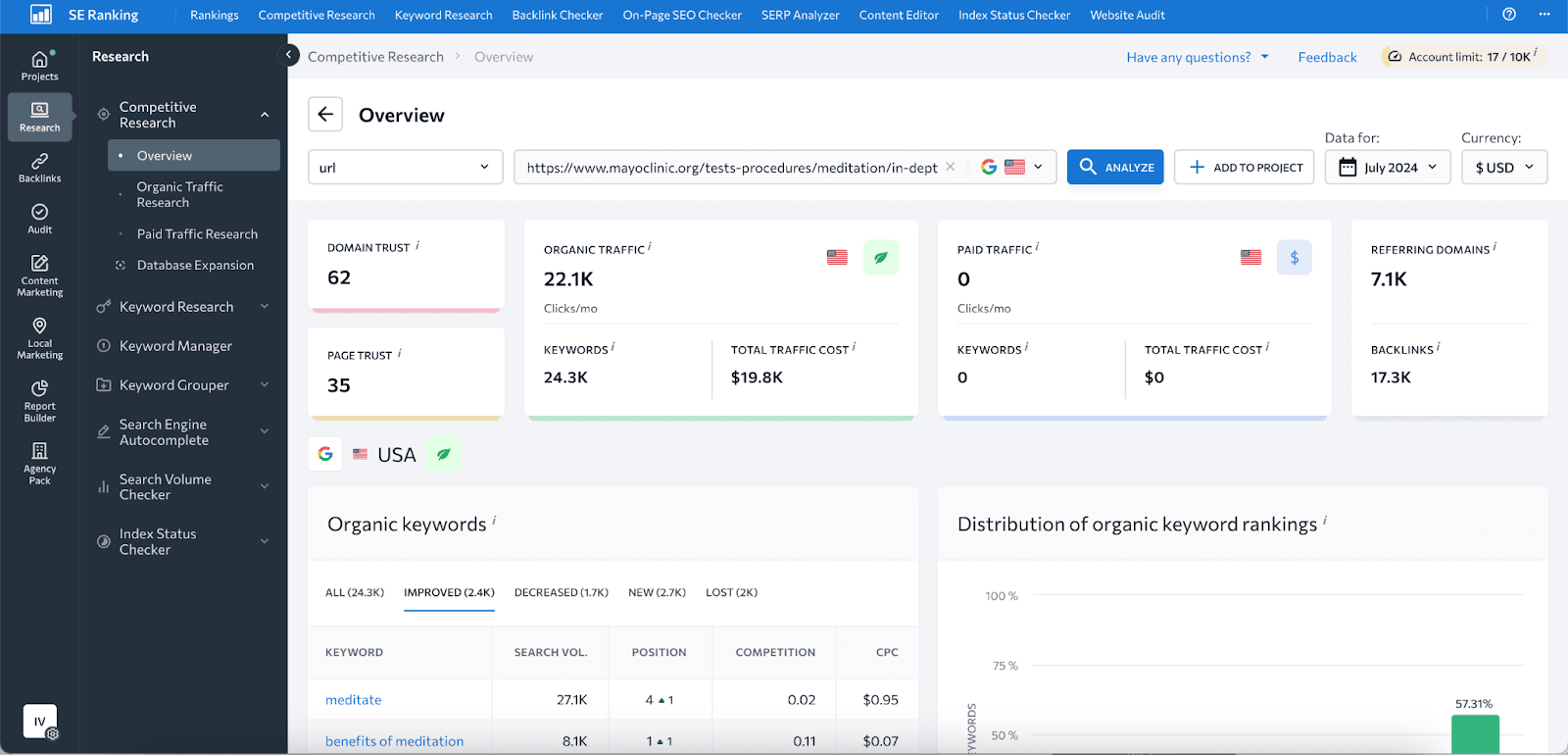
This 1,800-word article contains 5 bulleted lists, including 3 labeled lists (a format that AI content generators often favor). Despite this, the content passes the AI detector check and is marked as human-generated.
The author, specified as Mayo Clinic Staff, published the article on December 14, 2023. There is no schema markup on this page (check results).
- https://www.forbes.com/health/nutrition/soy-milk/
Google has cited this article over 100 times for soy milk-related keywords in the Food and Beverage niche.
It ranks in the top 10 in the US for the soy milk keyword (monthly search volume: 40,500). The page has organic visibility for 3.2K keywords, with 5.8K estimated organic traffic per month. Despite this, the article has only 9 referring domains and 12 backlinks.
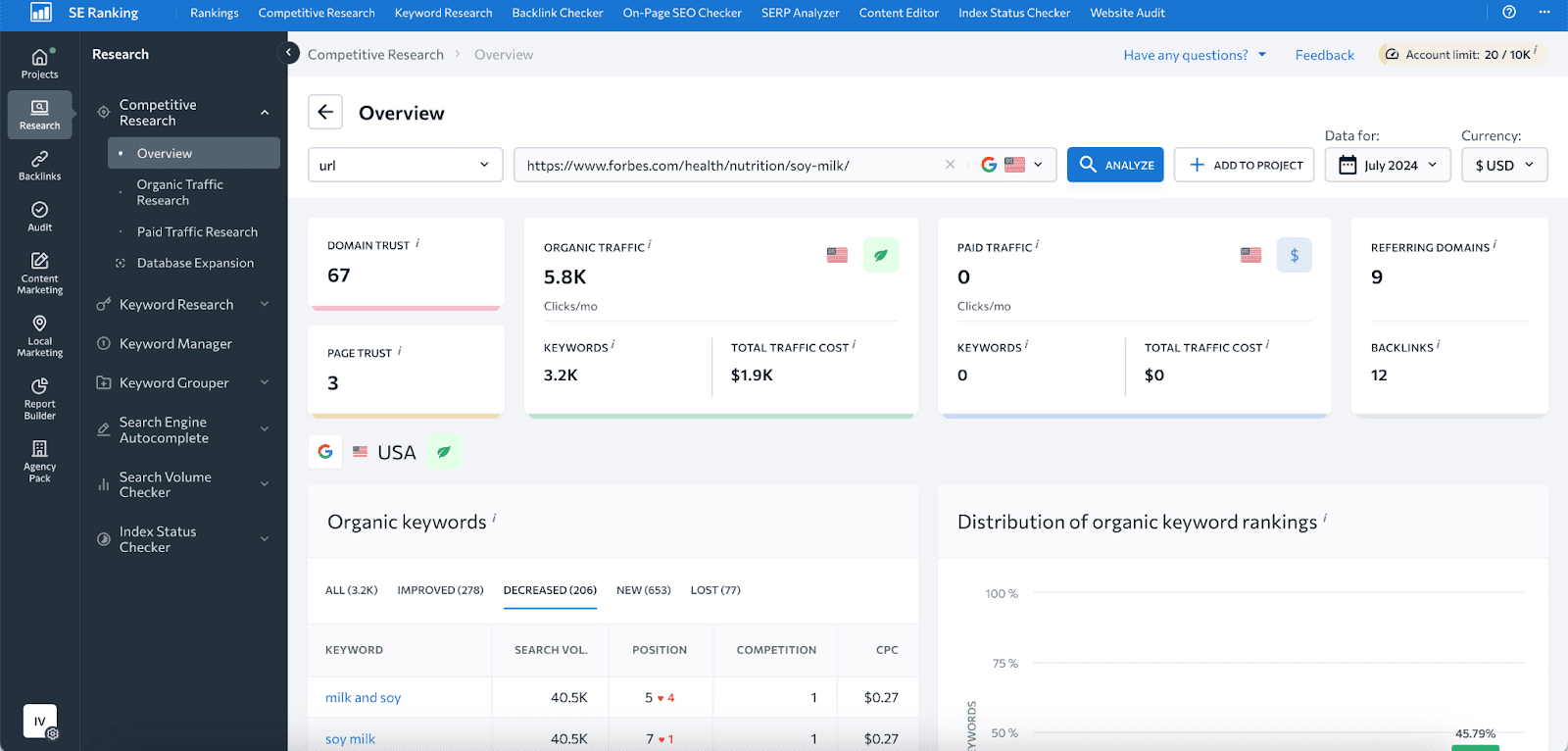
The article’s body content word count is 1,591 words, structured into small subsections with 3 headings in question format. The content has been marked as human-generated.
The authorship is attributed to Sarah Hays Coomer (contributor), with fact-checking by Alena Hall (editor). The article was last updated on January 9, 2024.
The page includes Article structured data (check results).
- https://www.techtarget.com/searchenterpriseai/definition/AI-Artificial-Intelligence
Google has used this link as a source about 100 times for keywords related to artificial intelligence in the Technology niche.
It ranks in the US’s top 10 for the artificial intelligence keyword (monthly search volume: 165K). The page is visible organically for 10.1K keywords, with monthly traffic forecast of 96.4 clicks. It has 4.4K referring domains and 9.8K backlinks.
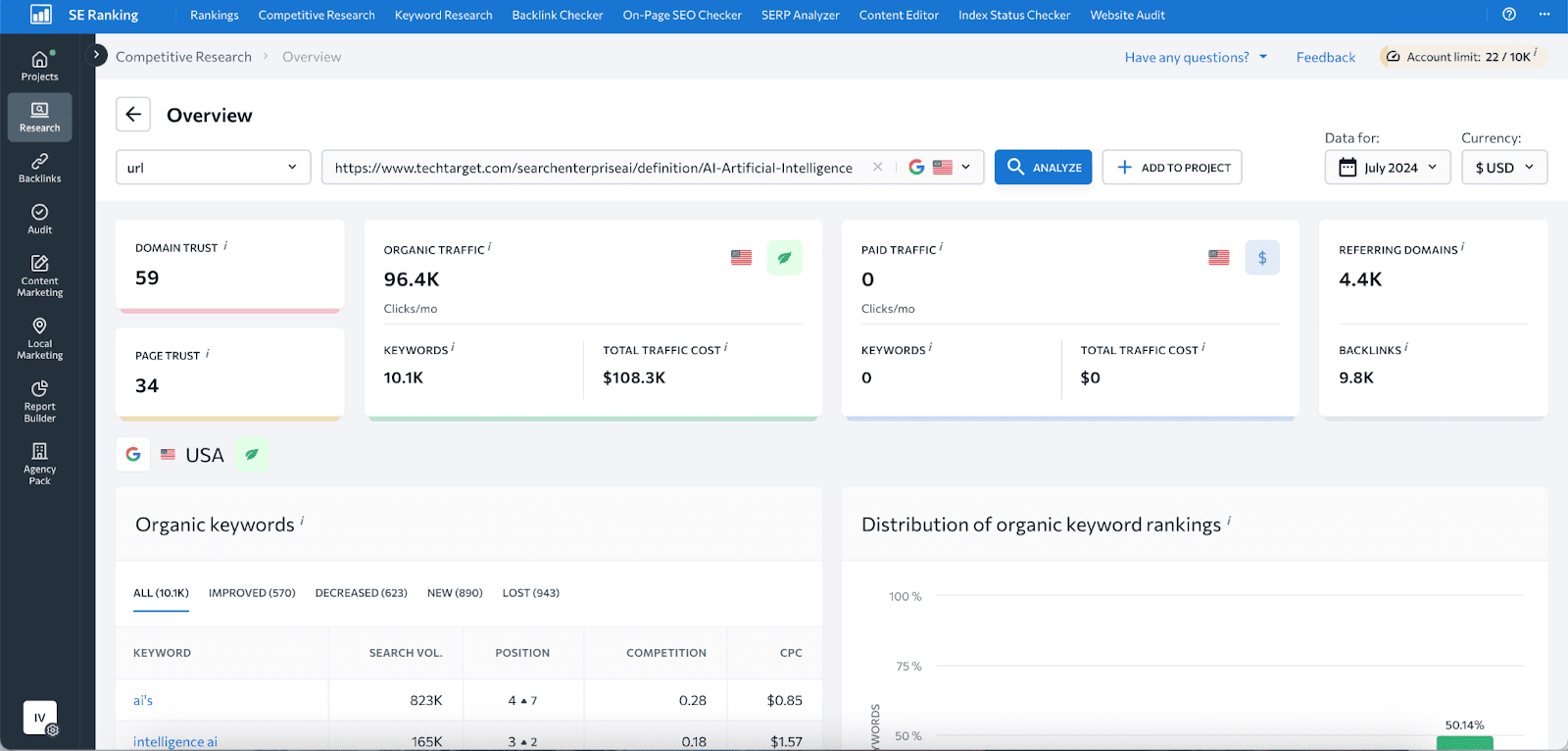
It is a comprehensive, 7,329-word guide that is well-structured, broken apart into small subsections. It features numerous question headings, bulleted lists, 2 YouTube videos, infographics, and many links to informational sources. The content has been verified as human-generated.
The article has clearly indicated authors with links to their profiles:
- Lev Craig, Site Editor
- Nicole Laskowski, Senior News Director
- Linda Tucci, Industry Editor — CIO/IT Strategy
George Lawton is also credited as a contributor, but no link to his profile is provided.
The article was last updated in October 2024 and the page includes three types of structured data (check results): Articles, Paywalled Content, and Videos.
LinkedIn links:
- https://www.linkedin.com/pulse/art-building-relationships-strategies-successful-business-kumawat
This page was cited by Google over 100 times for keywords from the Relationships niche.
According to our data (SE Ranking data), this page has no referring domains or backlinks and ranks for only two keywords. It contains 396 words and was created on February 25, 2023. If you check the link as a non-logged-in user, there is no information about the author, except for their name.
Two different AI content detectors mark this article as entirely AI-generated.
- https://www.linkedin.com/pulse/10-reasons-why-travel-so-important-build-life-erin-smith-uc9xc
This LinkedIn article was cited 3 times for keywords from the Travel niche (note that keywords from this niche triggered only 66 AIOs).
The article ranks for 53 keywords in the US, many of which are in the top 10 (for instance, why traveling is important, with a search volume of 590). The page has no referring domains or backlinks.
This article follows a “10 Reasons” format, which is likely why it is frequently sourced in AIOs. With 1,237 words contained in the body text, the content is flagged as 55% AI-generated by one AI detector, while another considers it entirely AI-generated.
The author is a travel advisor and travel agency owner, Erin Smith. The article was published on March 25, 2024.
Both LinkedIn articles have two types of structured data: Articles and Paywalled Content (first article results, second article results). Both authors have over 1K followers. Google likely considers this significant.
Most of the pages appearing frequently in AIOs rank highly for relevant keywords and have substantial organic visibility and backlink profiles. These articles vary in content length, but they often use lists and subsections with question-based headings. This formatting, as well as the use of structured data, makes content easier to understand. Additionally, some articles feature expert authors and fact-checkers, which enhances E-E-A-T.
To increase the odds of your content making it to AIO sources, consider diversifying its format, incorporating lists, FAQs, videos, etc. Don’t forget to implement structured data. This makes content clearer and easier to process.
Your content should have an expert author, credible sources cited, and be fresh or regularly updated. This boosts its authority and builds trust with readers and search engines.
How AI Overviews link to major media or UGC platforms
For this research, we selected 21 websites, including big media and User Generated Content platforms to check how many links from AIOs they get, the niches they appear for, and much more. We divided these websites into two groups.
Media outlets:
- forbes.com
- entrepreneur.com
- businessinsider.com
- inc.com
- mashable.com
- 9to5google.com
- searchenginejournal.com
- techcrunch.com
- searchengineland.com
- theguardian.com
- techradar.com
- wired.com
- theverge.com
- washingtonpost.com
- wsj.com
Forums & Social Media:
- reddit.com
- quora.com
- linkedin.com
- wikipedia.org
- youtube.com
- stackoverflow.com
Important note! This data is highly dependent on the keywords selected for our research, their search intent, and the keywords that triggered the AIOs in general. AIOs typically appear in search results for long-tail search queries with informational intents (what is, how to, etc.). These likely aren’t the typical keywords that media content appears for.
Do the analyzed websites get featured in AI Overviews and how often?
The top 5 frequently mentioned media in AI Overviews are:
- Forbes: 804 links pointing to its website from 723 AIOs.
- Business Insider: 148 links to its website from 139 AIOs.
- Entrepreneur: 45 links to its website from 44 AIOs.
- Inc: 36 links to its website from 36 AIOs.
- The Guardian: 35 links to its website from 35 AIOs.
The table below contains data on all the analyzed media outlets with their AIO and link counts:
AIO count
723 AIOs
Link count
804 links
AIO count
139 AIOs
Link count
148 links
AIO count
44 AIOs
Link count
45 links
AIO count
36 AIOs
Link count
36 links
AIO count
35 AIOs
Link count
35 links
AIO count
25 AIOs
Link count
25 links
AIO count
15 AIOs
Link count
15 links
AIO count
13 AIOs
Link count
18 links
AIO count
7 AIOs
Link count
7 links
AIO count
6 AIOs
Link count
7 links
AIO count
5 AIOs
Link count
5 links
AIO count
5 AIOs
Link count
5 links
AIO count
3 AIOs
Link count
3 links
AIO count
3 AIOs
Link count
3 links
AIO count
0 AIOs
Link count
0 links
723 AIOs
804 links
139 AIOs
148 links
44 AIOs
45 links
36 AIOs
36 links
35 AIOs
35 links
25 AIOs
25 links
15 AIOs
15 links
13 AIOs
18 links
7 AIOs
7 links
6 AIOs
7 links
5 AIOs
5 links
5 AIOs
5 links
3 AIOs
3 links
3 AIOs
3 links
0 AIOs
0 links
As for the Forums & Social Media group, we can see that the following platforms are leading:
- YouTube: 1,346 links from 946 AIOs.
- LinkedIn: 1,091 links from 905 AIOs.
- Wikipedia: 726 links from 635 AIOs.
The table below contains data on AIO and link counts for all the analyzed Forums & Social Media websites:
AIO count
946 AIOs
Link count
1,346 links
AIO count
905 AIOs
Link count
1,091 links
AIO count
635 AIOs
Link count
726 links
AIO count
0 AIOs
Link count
0 links
AIO count
0 AIOs
Link count
0 links
AIO count
0 AIOs
Link count
0 links
946 AIOs
1,346 links
905 AIOs
1,091 links
635 AIOs
726 links
0 AIOs
0 links
0 AIOs
0 links
0 AIOs
0 links
Reddit and Quora rarely appear in AI-generated responses, even though Google bought Reddit’s users’ content to train its AI. According to our research, none of the 100,013 analyzed keywords generated AIOs with links to Reddit and Quora. Here is how the number of links to these sites evolved across our three studies:
Data as of January 30, 2024
127,344 links
Data as of June 3, 2024
61,861 links
Data as of July 11, 2024
51,745 links
Data as of January 30, 2024
1,173 links
Data as of June 3, 2024
16 links
Data as of July 11, 2024
0 links
Data as of January 30, 2024
3,701 links
Data as of June 3, 2024
1 link
Data as of July 11, 2024
0 links
127,344 links
61,861 links
51,745 links
1,173 links
16 links
0 links
3,701 links
1 link
0 links
It looks like Google reduced Reddit and Quora’s occurrence in AIOs, probably to improve the quality of its answers, especially after numerous cases of hallucinations.
As for websites that fall into several niches, the media group is led by:
- Forbes.com (15 niches out of 20). Forbes dominates in several niches, in particular Business (162 AIOs, 228 links), Finance (151 AIOs, 158 links), and Food and Beverage (157 AIOs, 157 links).
- Business Insider (9 niches out of 20). Business Insider has a high number of AIOs and links in the Relationships (73 AIOs, 81 links), Self-Care and Wellness (24 AIOs, 24 links), and Finance (18 AIOs, 18 links) niches.
- Mashable (8 niches out of 20): Mashable leads in the Sports and Exercise (6 AIOs, 6 links), Education (2 AIOs, 2 links), and Relationships (2 AIOs, 2 links) niches.
- The Guardian (8 niches out of 20): The Guardian’s top niches are Relationships (13 AIOs, 13 links), Self-Care and Wellness (6 AIOs, 6 links), and Food and Beverage (5 AIOs, 5 links).
- Entrepreneur (7 niches out of 20): Entrepreneur appears mostly in the Business (21 AIOs, 22 links), Technology (8 AIOs, 8 links), and Self-Care and Wellness (6 AIOs, 6 links) niches.
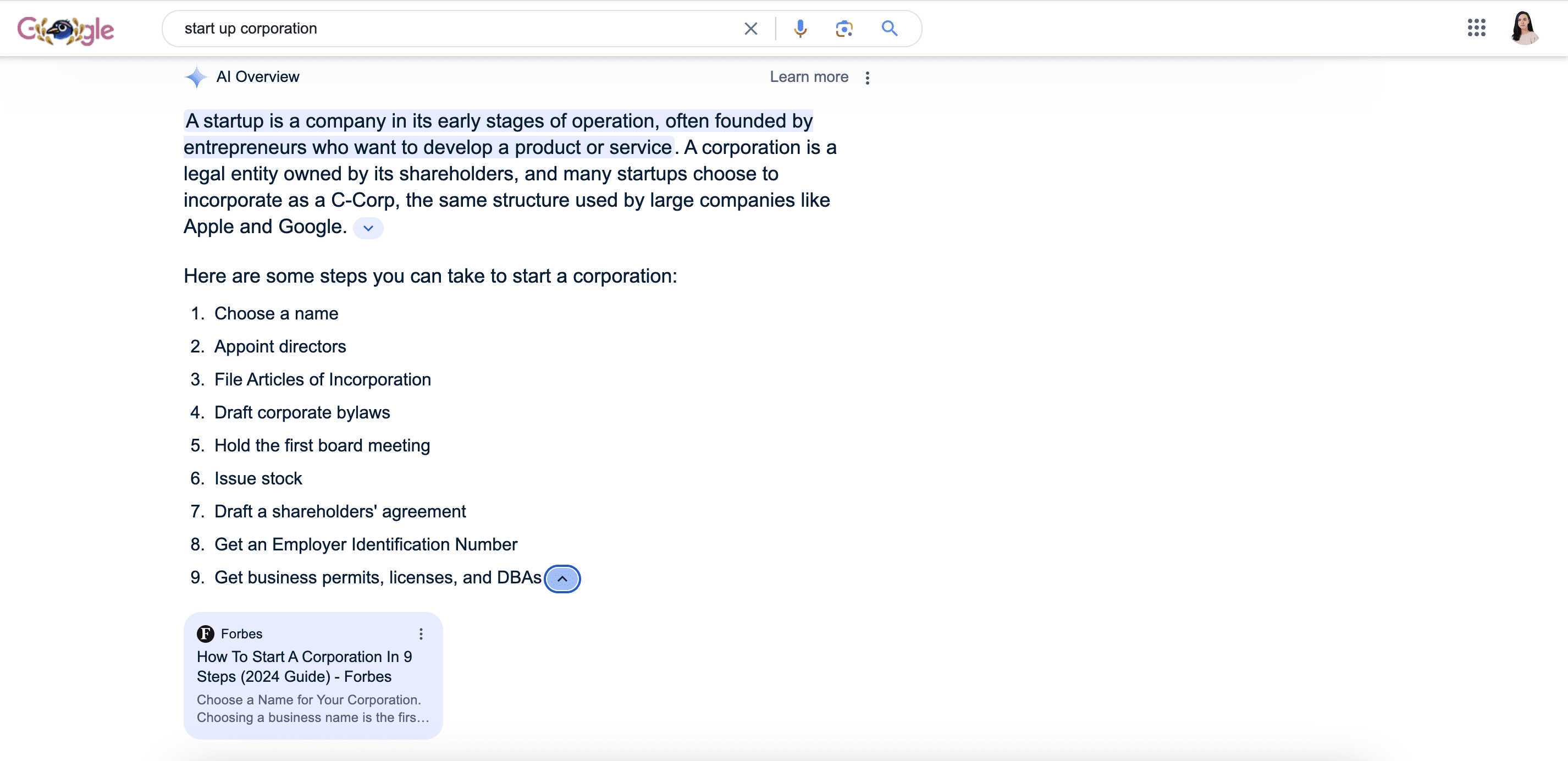
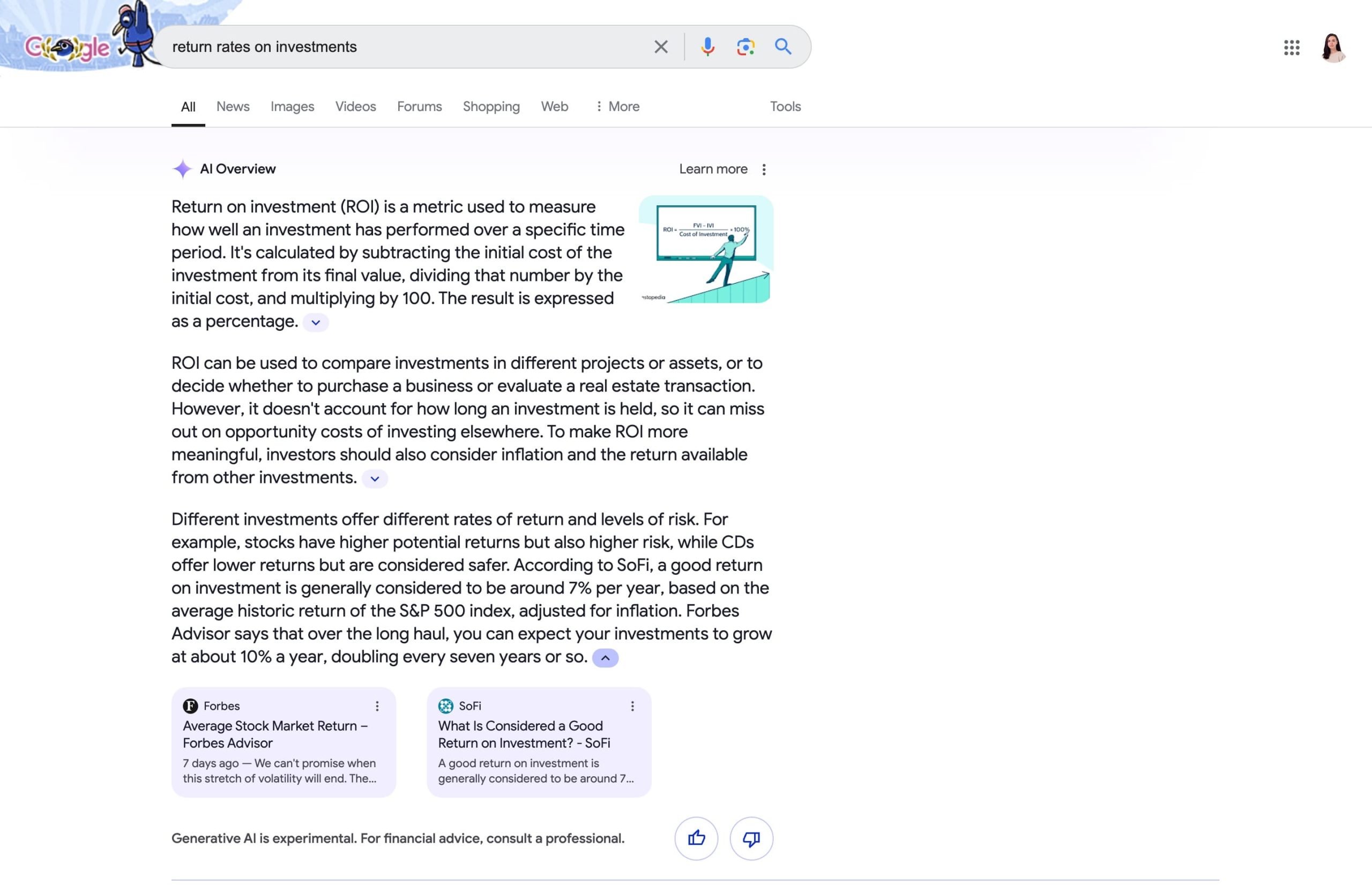
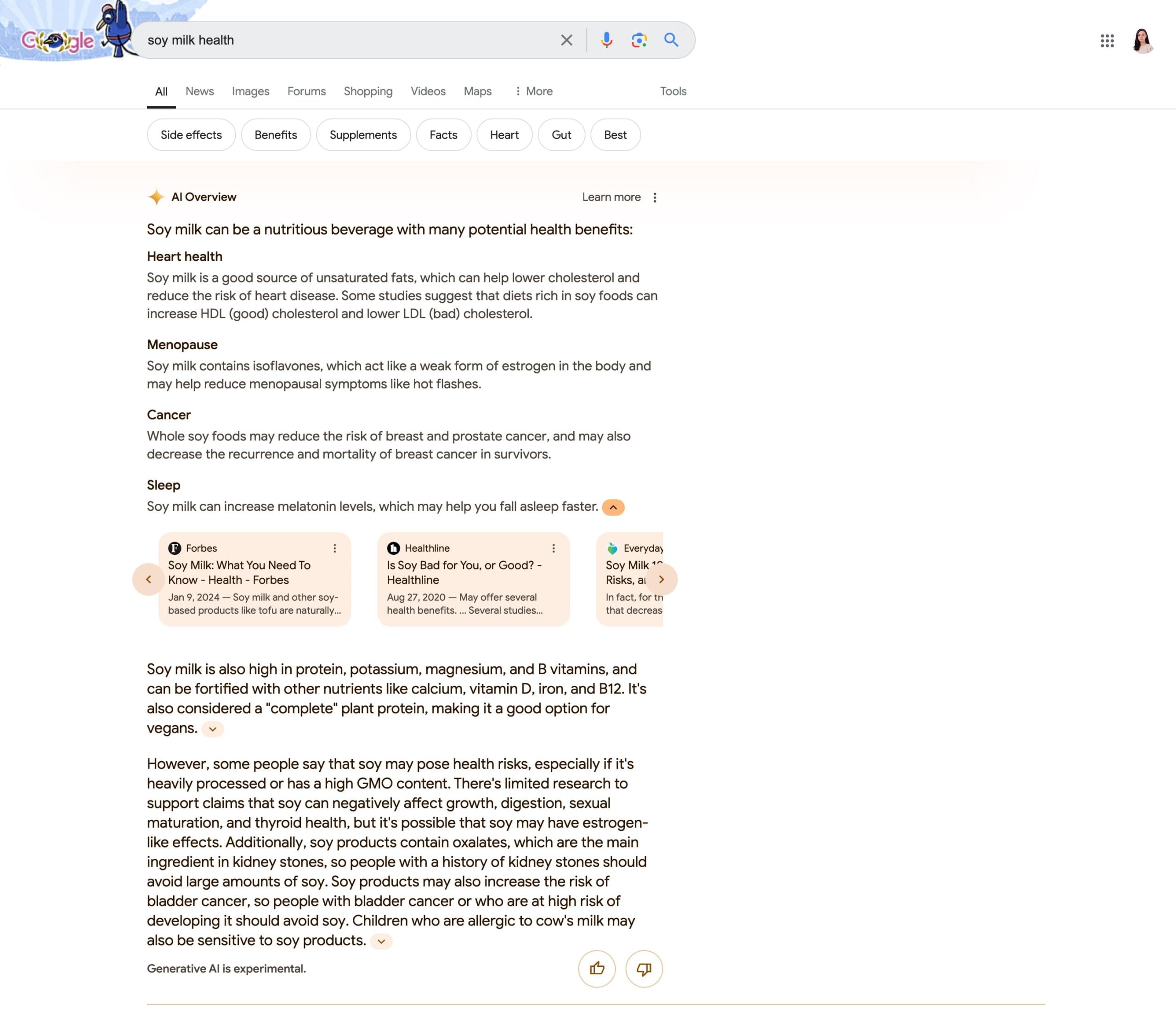
The Forums & Social Media group is led by:
- Wikipedia.org (18 niches out of 20). Wikipedia shows significant appearances in many niches, with the highest in Entertainment and Hobbies (99 AIOs, 151 links), Food and Beverage (114 AIOs, 122 links), and Relationships (121 AIOs, 125 links).
- Youtube.com (17 niches out of 20). YouTube demonstrates a dominant role in Food and Beverage (195 AIOs, 292 links), Self-Care and Wellness (185 AIOs, 283 links), and Technology (168 AIOs, 231 links).
- Linkedin.com (15 niches out of 20). LinkedIn has a very high number of AIOs and links in Relationships (378 AIOs, 478 links) and Business (193 AIOs, 234 links).
Websites like Reddit, Quora, and Stackoverflow, which we attributed to this group, show zero presence.
For a detailed breakdown of each website by niches, check out this file.
Do the analyzed websites appear in both AI Overviews and TOP 10 organic search results?
The top-performing websites mentioned in the previous section continue to dominate the number of keywords with links, appearing in both AIOs and the TOP 10 organic search results:
- Media outlets:
- Forbes has the highest count with 562 keywords
- Business Insider follows with 49 keywords
- Washington Post takes third, with 20 keywords
- The Guardian has 13 keywords
- Forums & Social Media group:
- Wikipedia leads with 426 keywords
- LinkedIn shows a strong performance with 212 keywords
- YouTube follows with 118 keywords
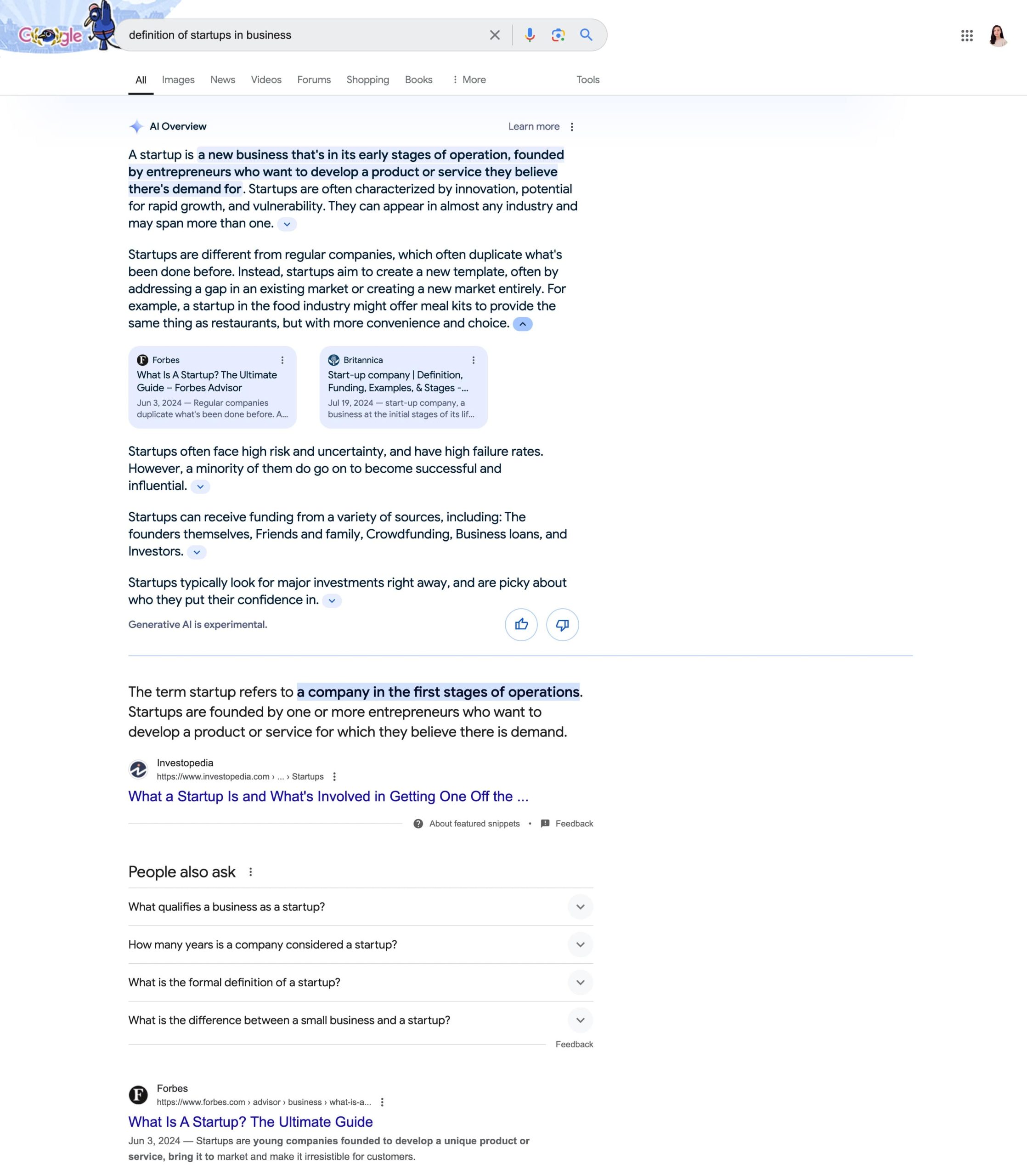
Overall, for a quarter of the analyzed websites, including 9to5Google, Quora, Reddit, Search Engine Land, and Stack Overflow, no keywords trigger the SERPs with matching links between AIOs and the top 10 organic search results.
Do the analyzed websites appear in both AI Overviews and featured snippets?
There is 1 top-performing website in the media outlets group:
- Forbes.com: 33 keywords with links in both AIOs and featured snippets
Business Insider and Inc were both linked in AI Overviews and featured snippets, by 2 and 1 keywords, respectively. Most of the analyzed media (15 websites) didn’t appear in both AIOs and featured snippets.
The Forums & Social Media group shows a relatively higher performance:
- Wikipedia: 55 keywords with links in both AIOs and featured snippets
- LinkedIn: 17 keywords with links in both AIOs and featured snippets
- YouTube: 5 keywords with links in both AIOs and featured snippets
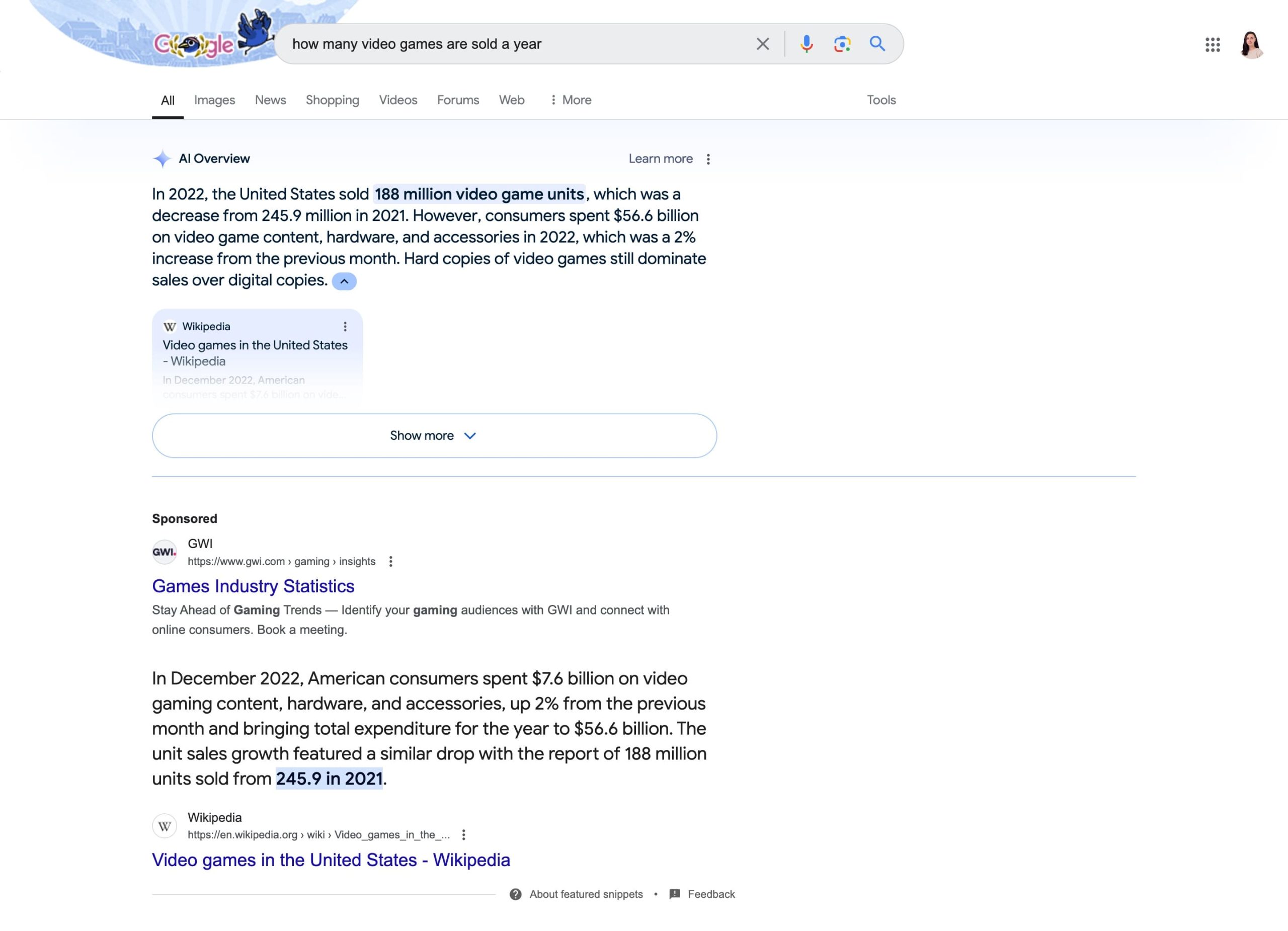
Major media platforms are more frequently featured in AIOs because they are authoritative and trustworthy resources. But again, the data we collected is based off of the keywords we chose for our analysis. If we analyzed other keywords, the situation might have been different. Also, we found that UGC platforms currently struggle for visibility in AIOs. This might be due to the unpredictable quality of user-generated content.
How often do AI Overviews link to .gov websites?
Government websites are often considered authoritative sources of information. We observed them closely to determine how frequently Google’s AI Overviews incorporate them in answers. Note that we only focused on the .gov website for the US.
Out of 7,475 keywords triggering AIOs, 1,473 keywords (19.71%) resulted in AIOs with links to .gov websites. This means nearly one in five AI Overviews references a government source.
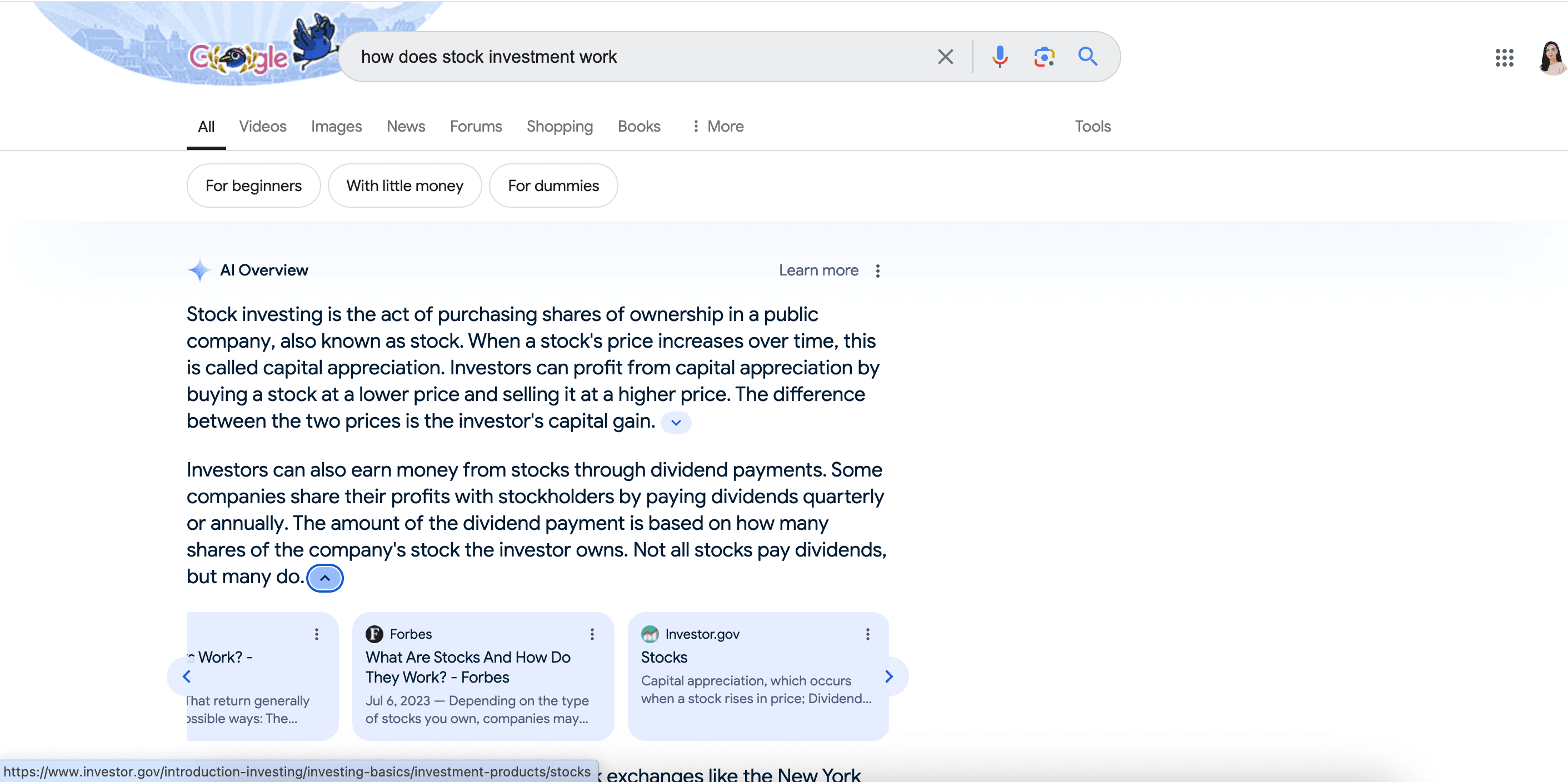
Out of 51,745 links discovered during this research, 1,808 links (3.49%) went to .gov websites.
Important note: The data below is shown in percentages only. We calculated it based on a small number of keywords. However, percentages offer the clearest comparison for this context.
For distribution by niche, we see that the Healthcare niche has the highest percentage of both keywords triggering AIOs with links to .gov domains (60.71%) and links in this niche to .gov sites (29.81% of its total links).
Niches heavily regulated by the government also show high percentages:
- Insurance: 35.87% of keywords, 10.48% of links
- Career and Jobs: 31.25% of keywords, 8.11% of links
- Legal: 25% of keywords, 4.69% of links
The Relationships niche has a high percentage too (37.40% of keywords, 6.30% of links), possibly due to government resources on family services or social programs.
With 23.16% of keywords and 3.97% of links, Food and Beverage likely references FDA or USDA guidelines frequently.
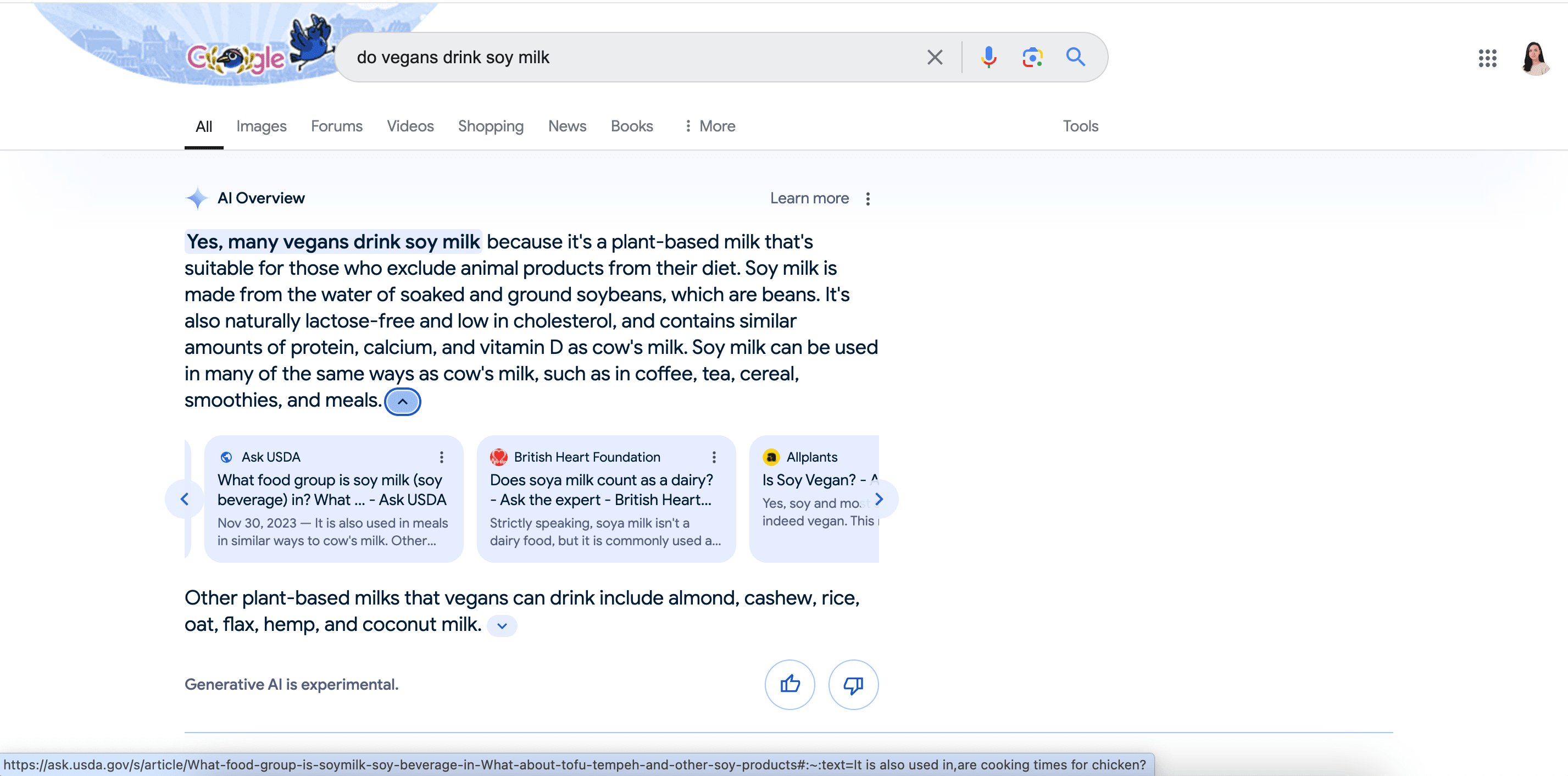
Some niches show very low or no .gov presence:
- Real Estate and Ecommerce: 0% for both metrics
- Education (surprisingly low!): 0.58% of keywords and 0.08% of links
- Business: 2.15% of keywords and 0.31% of links
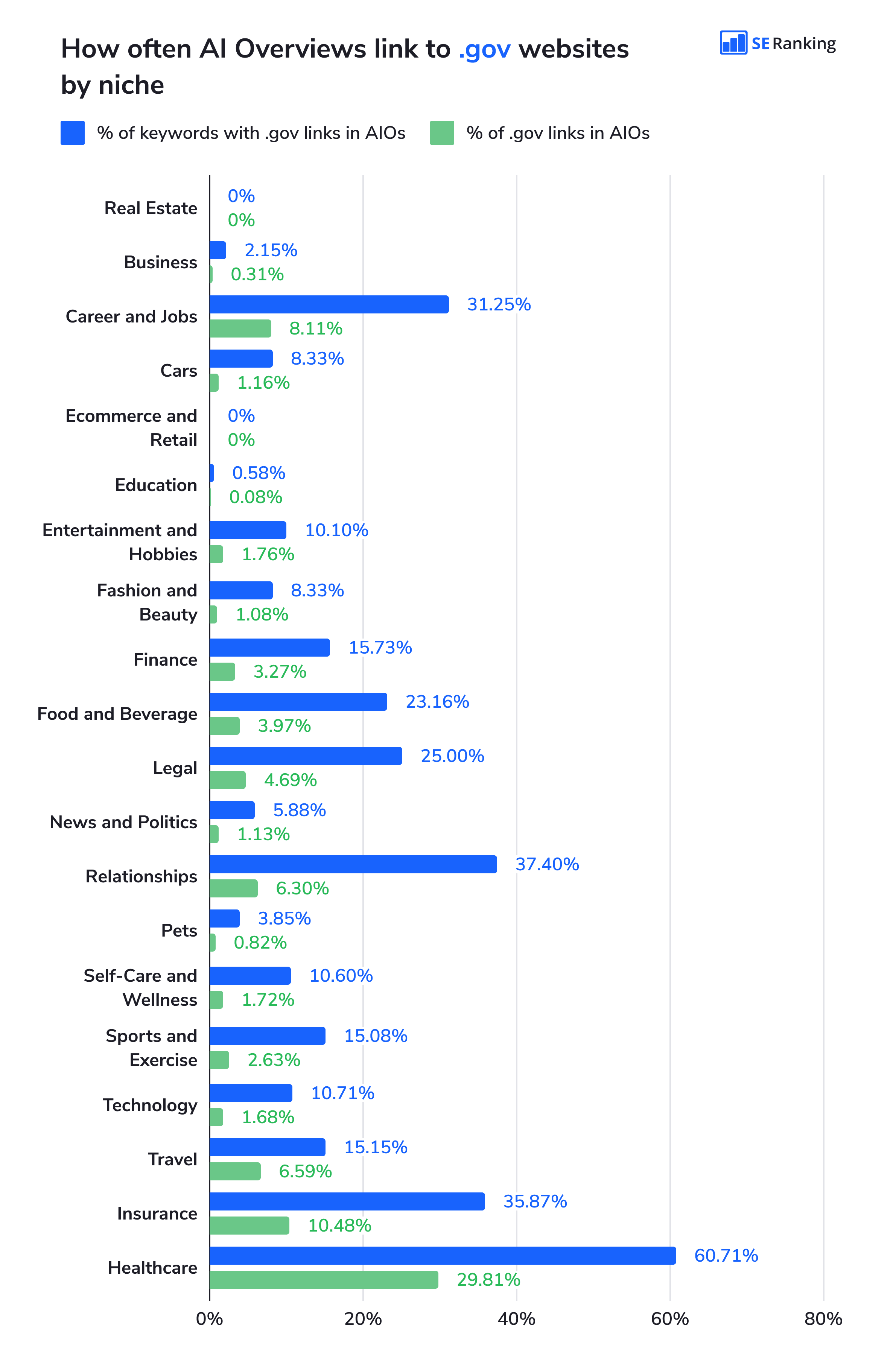
With nearly one in five AIOs referencing a government source, we see that Google trusts .gov websites as authoritative sources. This suggests Google tries to source information from recognized and official platforms, especially for topics that require extra accuracy and up-to-date data.
How often do AI Overviews link to .edu websites?
Our research reveals that out of 7,475 keywords triggering AIOs, 1,989 keywords (26.61%) result in AIOs containing links to .edu websites. This suggests that over a quarter of Google’s AI-generated responses reference educational institutions or academic resources.
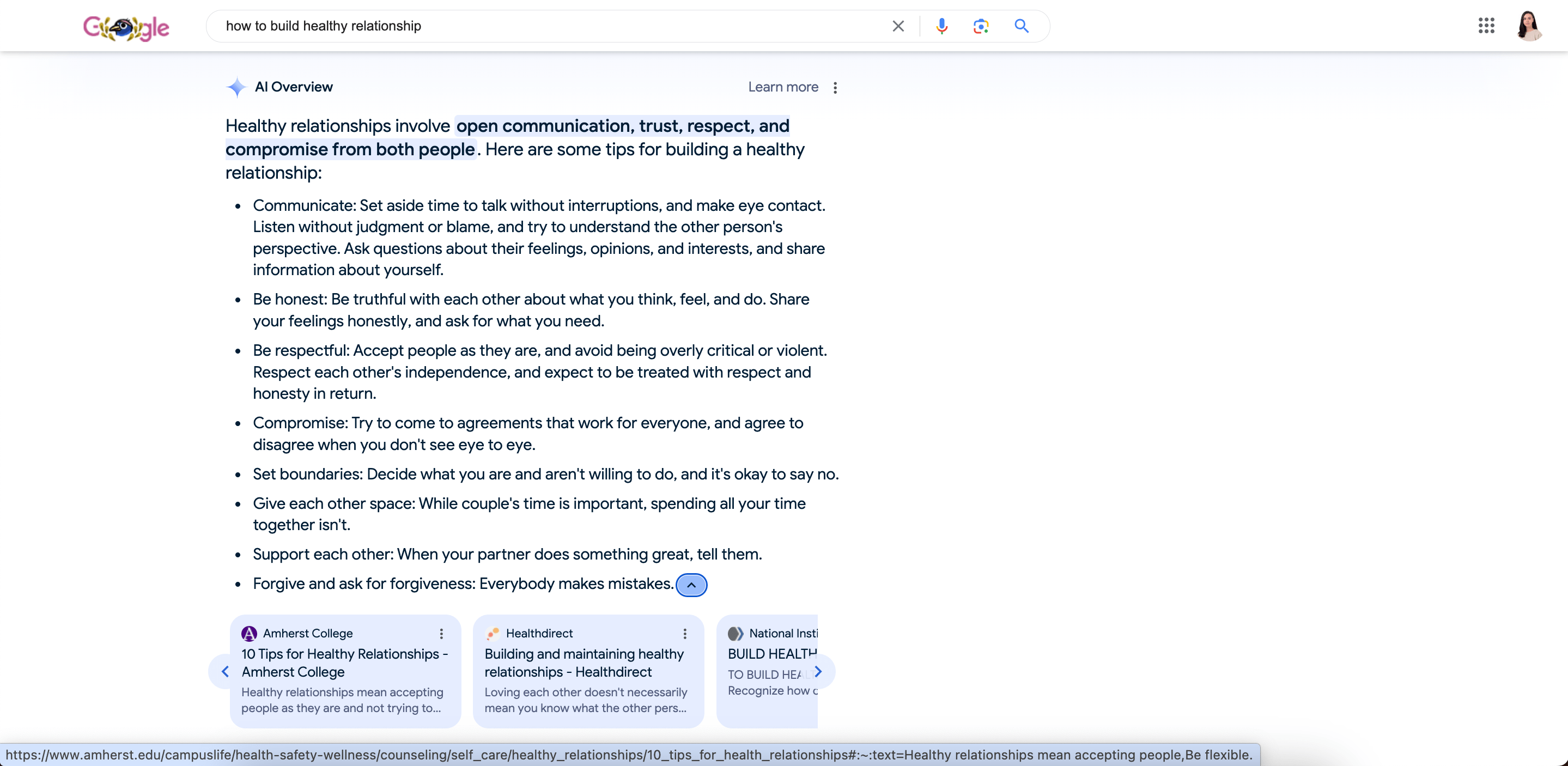
Out of the total 51,745 links discovered during this research, 2,497 links (4.85%) direct users to .edu websites.
Important note: We present data only in percentage form based on a small sample of keywords. While the sample size is small, percentages offer the most accurate basis for comparison.
The distribution of .edu links across different niches varies considerably:
- Real Estate: 11.63% keywords, 11.63% links
- Relationships: 47.16% keywords, 8.47% links
- Legal: 43.75% keywords, 7.29% links
- Healthcare: 32.14% keywords, 6.21% links.
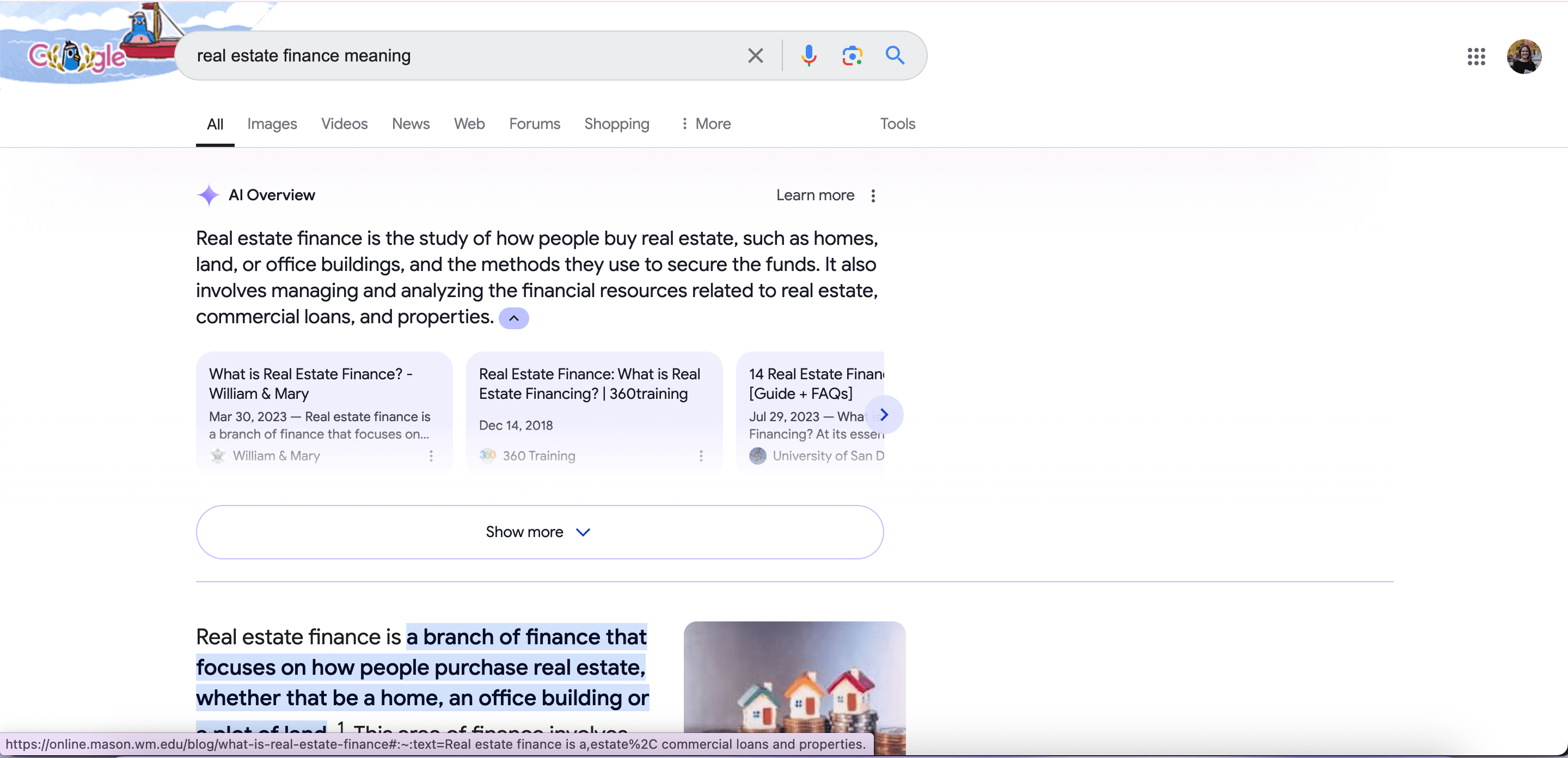
Most other niches have between 1-5% of their total AIO links pointing to .edu sites, including the Education niche. Only 4.80% of its links go to the .edu websites.
Finance shows the lowest percentage (0.10%) among niches with any .edu links.
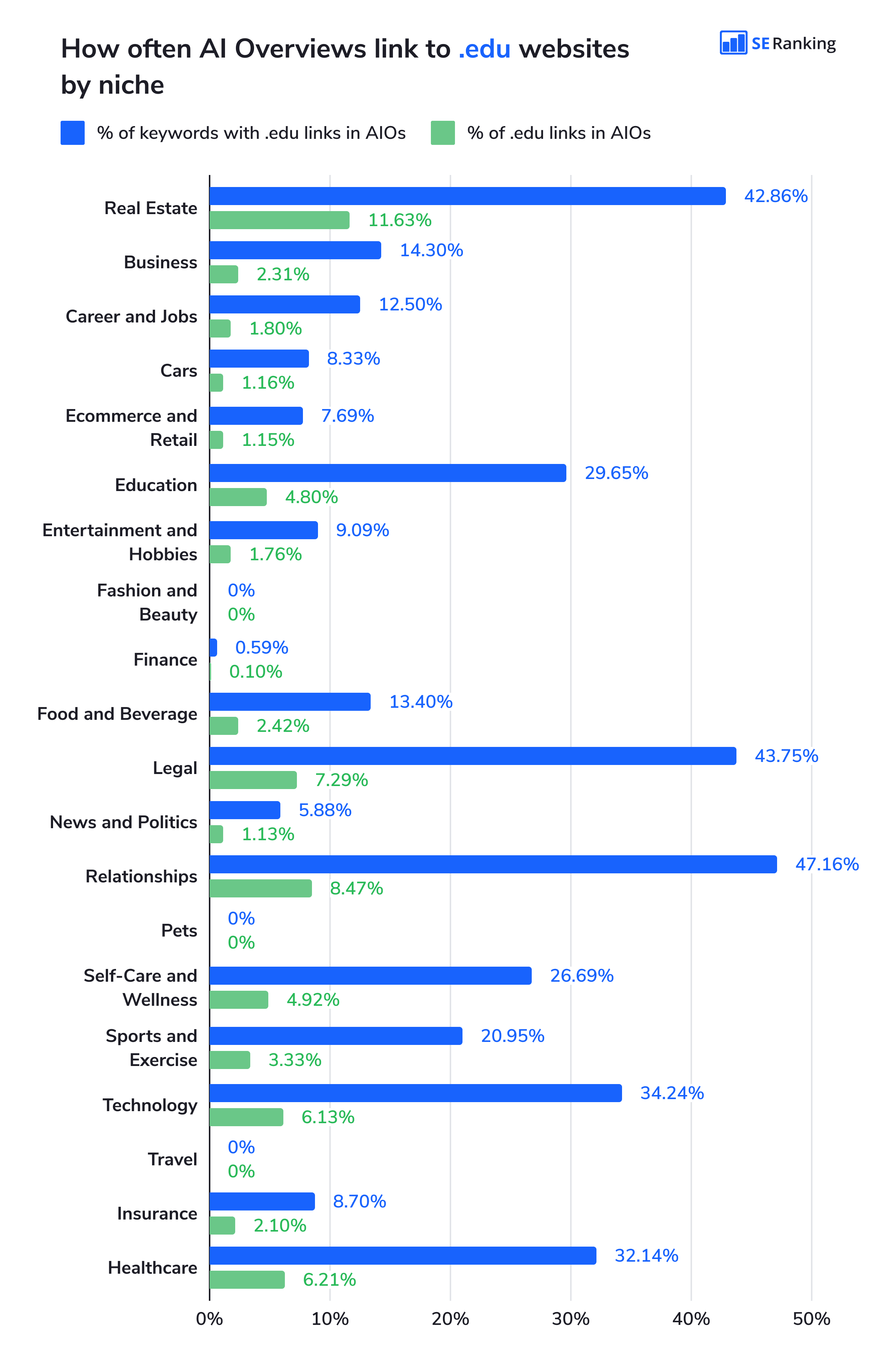
With 26.61% of AIOs featuring .edu links, we can say that Google values educational and academic resources and authoritative content associated with educational institutions. However, the distribution of .edu links varies across different niches.
Educating your users can be a good strategy if this applies to your business. You can establish connections with educational institutions, host or participate in educational webinars, and publish joint research.
How often do AI Overviews link to .mil websites?
AIOs include links to .mil websites on occasion, but less frequently than educational sources. Our research shows that out of 7,475 keywords triggering AIOs, only 440 keywords (5.89%) result in AIOs containing links to .mil websites.
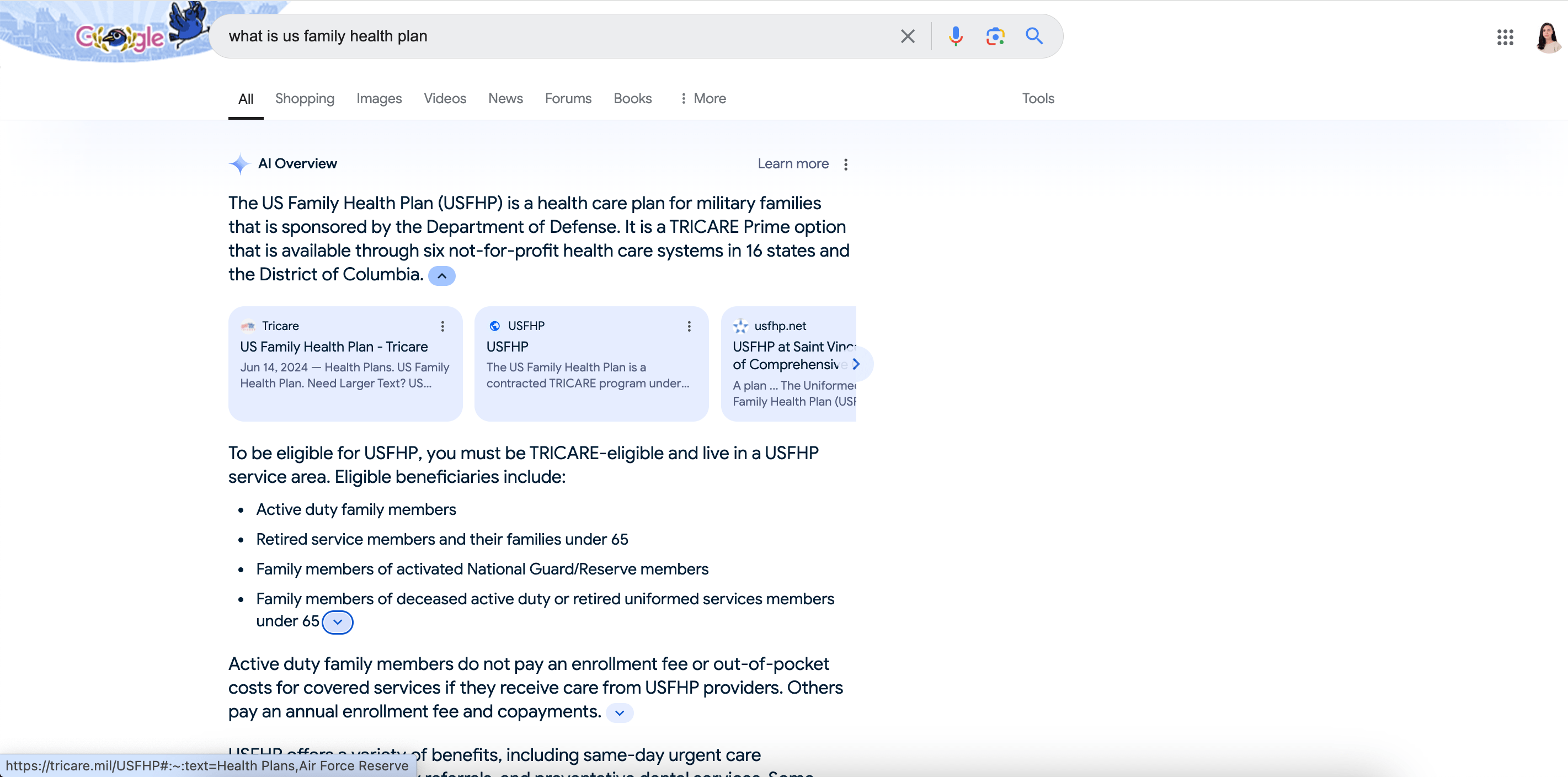
Of the 51,745 links discovered during this research, 441 links (0.85%) direct users to .mil websites.
Important note: Results are presented as percentages based on a select group of keywords. Despite the limited scope, this method offers the clearest comparative data view.
The distribution of .mil links across different niches is highly concentrated:
- The Relationships niche shows the highest prevalence of .mil links, with 21.56% of its keywords triggering AIOs with .mil links. Moreover, 2.97% of all links in this niche’s AIOs go to .mil websites. This might indicate that military resources are considered relevant for relationship-related topics, possibly due to content about military families or relationships in military contexts.
- Healthcare is the second most prominent niche for .mil links, with 3.57% of its keywords triggering AIOs with .mil links and 1.24% of its total AIO links going to .mil websites.
- Technology shows a minimal presence of .mil links, with only 0.24% of its keywords triggering AIOs with .mil links and a mere 0.03% of its total AIO links going to .mil websites.
- No other niche in our study showed keywords triggering AIOs with links to .mil websites.
Since only 5.89% of AIOs contain .mil links, and these links make up only 0.85% of all links, it is clear that .mil websites rarely appear in AIOs. However, this depends on the queries selected for analysis. Results may vary with different keywords.
How often do AI Overviews link to .in domains?
Lily Ray has been vocal about the issues surrounding Google’s AI Overviews, particularly concerning the inclusion of non-US and Indian websites featured in AIOs.
We decided to check how many keywords from our sample would trigger AI Overviews with links to .in domains.
Out of 7,475 keywords triggering AIOs, 736 keywords (9.85%) trigger SERPs with AIOs linking to .in websites. This is a moderate but notable presence for the US SERPs.
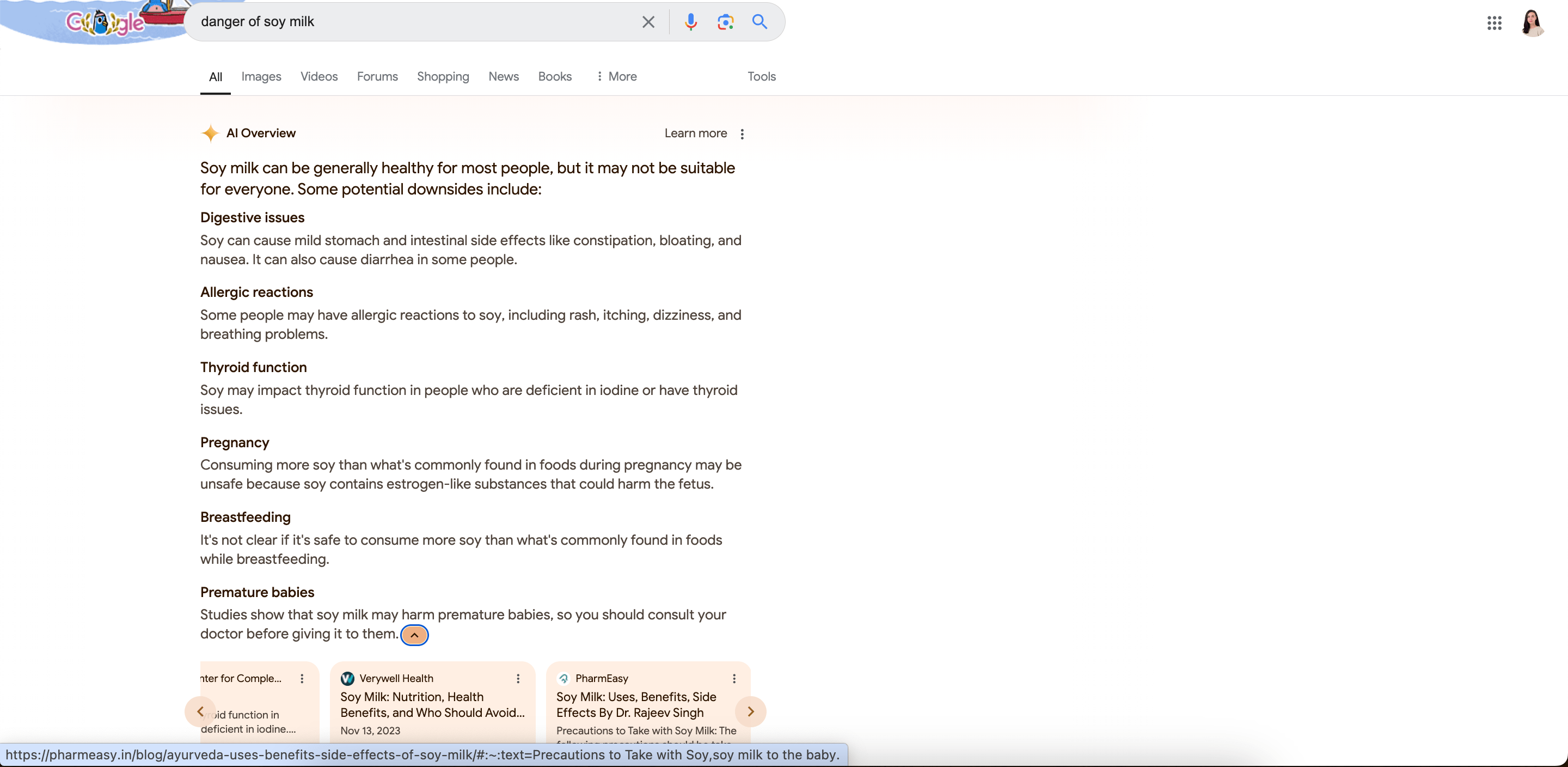
As for link count, of the 51,745 links discovered during our research, 880 links (1.70%) go to .in websites.
Important note: We calculated percentages based on a small sample of keywords. Still, this approach best captures comparative ratios.
The Sports and Exercise niche leads in both keywords triggering AIOs, with links to .in domains (36.83% of keywords) and links in this niche that go to .in websites (6.48% of links out of the niche’s total number of links).
Other leaders are:
- Food and Beverage: 18.49% of keywords, 3.60% of total niche links
- Fashion and Beauty: 16.67% of keywords, 2.15% of total niche links
- Insurance: 13.04% of keywords, 2.86% of total niche links
- Business: 8.56% of keywords, 1.27% of total niche links
Niches like Real Estate, Career and Jobs, Ecommerce and Retail, and News and Politics show zero keywords and links to .in domains.
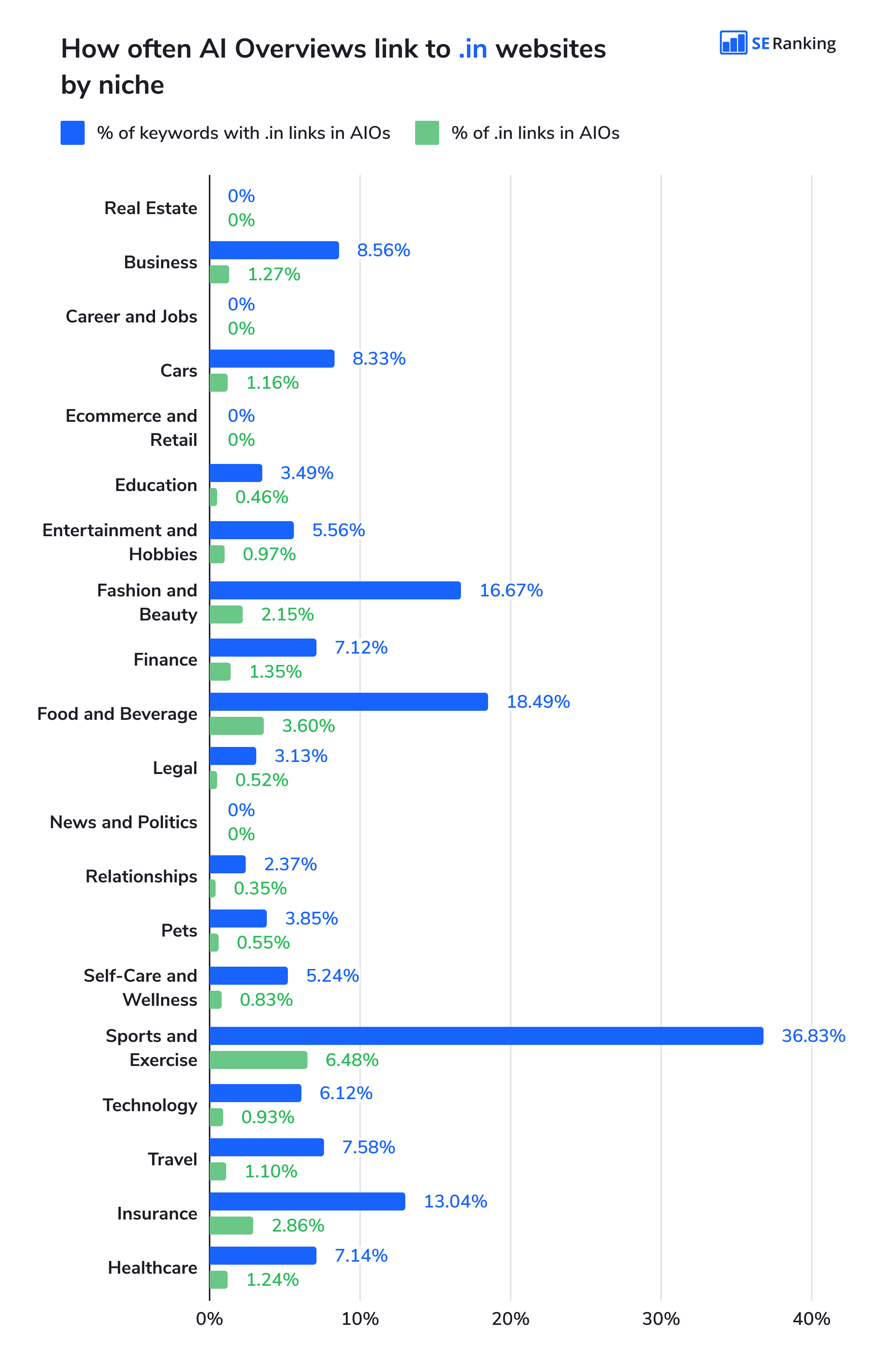
The appearance of .in websites in AI Overviews presents a unique challenge for US websites. These sources increase the pool of content that US websites must compete against. In addition, content from .in domains may offer perspectives or information that is contextually and culturally distinct from US expectations. Let’s take the Insurance niche, for instance. When searching for insurance-related information, users expect to see locally relevant content that highlights their region’s values and customs.
Lily Ray continues sharing insights on international domains in AI Overviews. We hope that Google fixes this problem because it’s irrelevant to show users in the US information from sites in other countries. Meanwhile, all we can do is only monitor the situation.
Do AI Overviews contain links to HTTP websites?
AIOs overwhelmingly favor secure HTTPS links over unsecured HTTP links. Out of the 51,745 links discovered in our research, only 130 links (0.25%) use the HTTP protocol. 51,615 links (99.75%) use the secure HTTPS protocol.
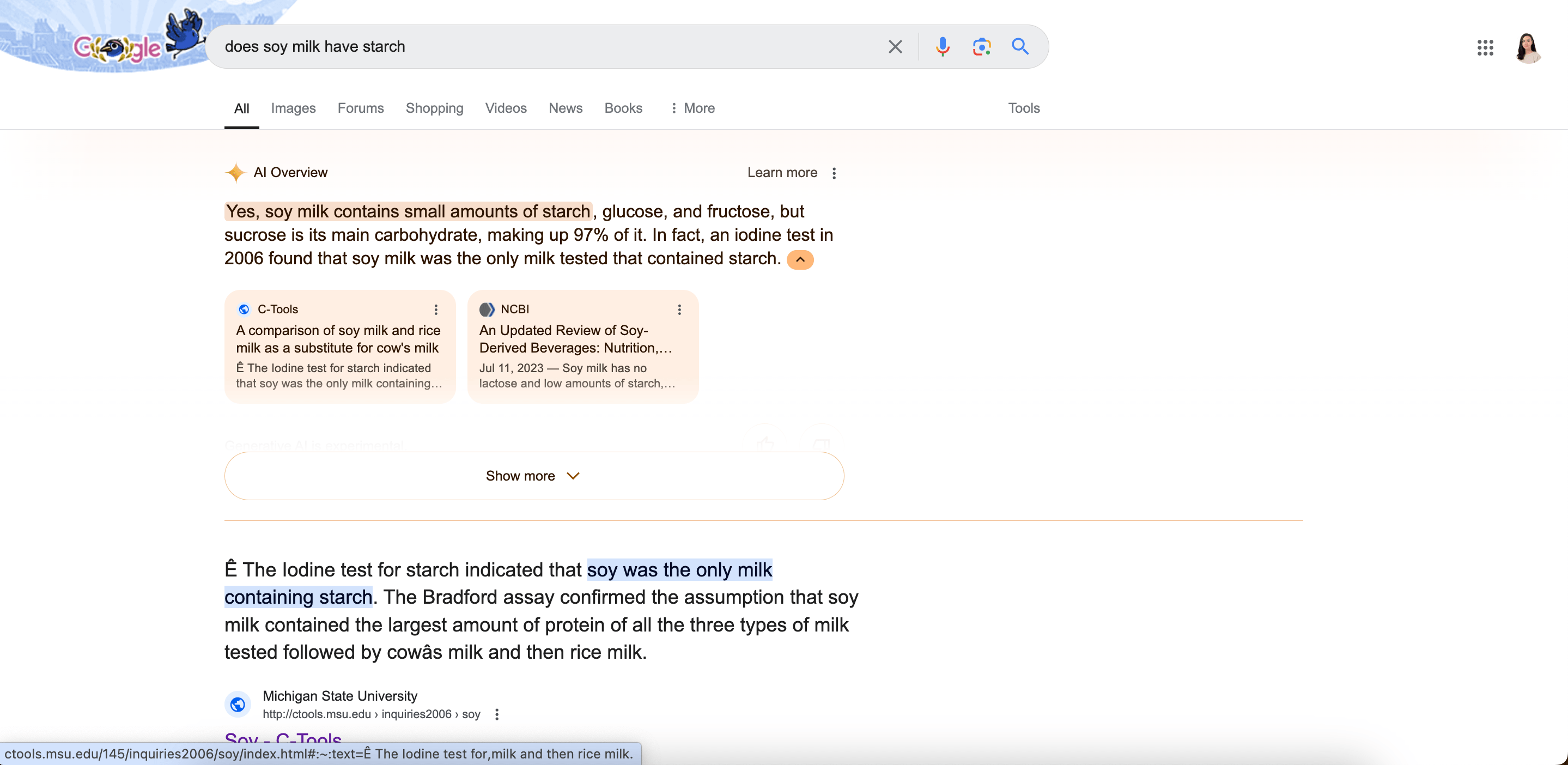
The distribution of HTTP vs. HTTPS links across niches reveals:
- Real Estate, Career and Jobs, Fashion and Beauty, Finance, Legal, and Pets show 100% HTTPS usage with no HTTP links.
- All other niches show near-complete HTTPS adoption.
- Education shows the highest percentage of HTTP links at 1.39%, though this is still very low.
If your website is still using HTTP, transitioning to HTTPS is essential. It enhances your security, builds trust with users, and makes your sites more SEO-friendly. Google clearly prefers HTTPS in AIOs.
Research methodology
This study was specifically designed to analyze the links and sources in Google’s AI Overviews. Our goal was to provide SEO specialists and website owners with insights and facilitate better-informed business and SEO decisions. Importantly, for this study, we used accounts without Google Labs when collecting data to ensure a more current view of AI-powered search.
Scope and data set
Our analysis covered 100,013 keywords across 20 niches:
- Business
- Career and Jobs
- Cars
- Ecommerce and Retail
- Education
- Entertainment and Hobbies
- Fashion and Beauty
- Finance
- Food and Beverage
- Healthcare
- Insurance
- Legal
- News and Politics
- Pets
- Real Estate
- Relationships
- Self-Care and Wellness
- Sports and Exercise
- Technology
- Travel
Each niche consisted of approximately 5,000 keywords with different search intents, volumes, and word counts (including short, medium, and long-tail keywords).
Technological framework
We created projects for each niche within the SE Ranking platform and used its AI Overview tracking functionality to capture and analyze how AI-generated answers integrate links from various sources in search results. We also used:
- Competitive Research Tool to collect organic keywords, organic traffic, and domain trust data
- Backlink Checker Tool to collect referring domains and backlinks.
- Website Audit tool to collect domain age data.
Parameters of the study
- Search Engine: Google
- Location: USA
- Region: New York, New York, United States
- Language: English (en)
Data collection configuration
We collected the data using Google Chrome on an Ubuntu PC. Sessions were conducted through Google accounts without Google Labs based in New York. All personalization features within the accounts were also disabled to eliminate any potential biases and maintain data integrity.
Execution timeline
We collected this data during a one-time check on July 11, 2024.
Conclusion and next steps
The results of this research have once again highlighted that AI-powered search optimization requires a holistic approach and continuous improvement of E-E-A-T.
We see that websites that get links in AI Overviews have built their authority over the years, but newer sites also have a chance to get their share of visibility in the new search if they offer unique perspectives and have robust backlink profiles. The main thing is to constantly monitor changes and respond to them in time. Our new AI Overviews Tracker tool can help with that! Sign up for the free trial to access the tool and start optimizing your website for AIOs before your competitors do.
Stay tuned for our next research study. We plan to release another one soon.

